Factors Affecting High Staff Turnover: The Case of Ausnew Company
VerifiedAdded on 2023/06/11
|29
|9395
|347
AI Summary
This research aims to examine the factors resulting in high staff turnover at Ausnew Company. The research employed both primary and secondary data for collecting good amount of resourceful information. The study focuses on the role of human resource department, leadership, motivation, and sound work environment in retaining employees. The research findings suggest that there are several factors responsible for high staff turnover rate at the company.
Contribute Materials
Your contribution can guide someone’s learning journey. Share your
documents today.
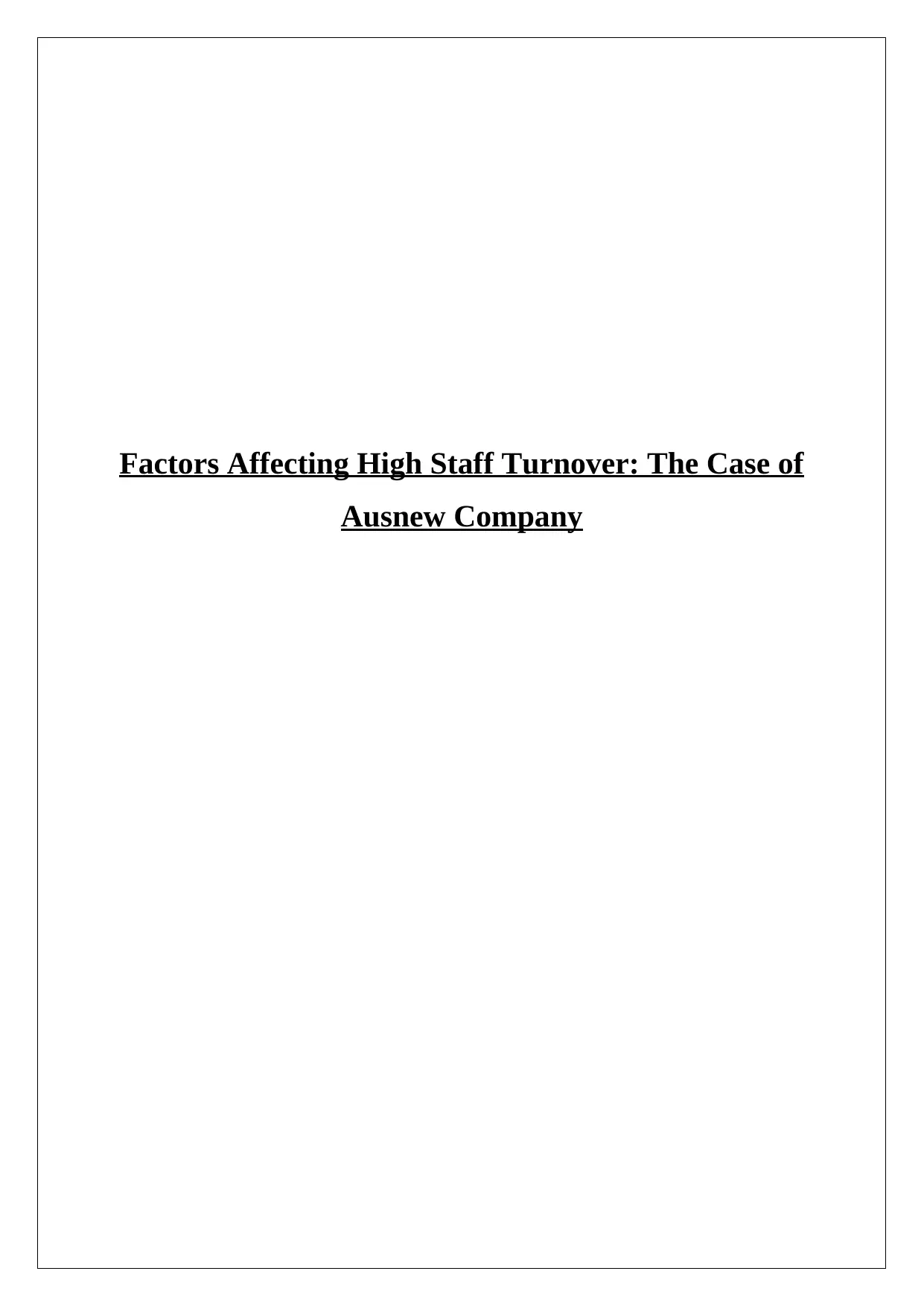
Factors Affecting High Staff Turnover: The Case of
Ausnew Company
Ausnew Company
Secure Best Marks with AI Grader
Need help grading? Try our AI Grader for instant feedback on your assignments.
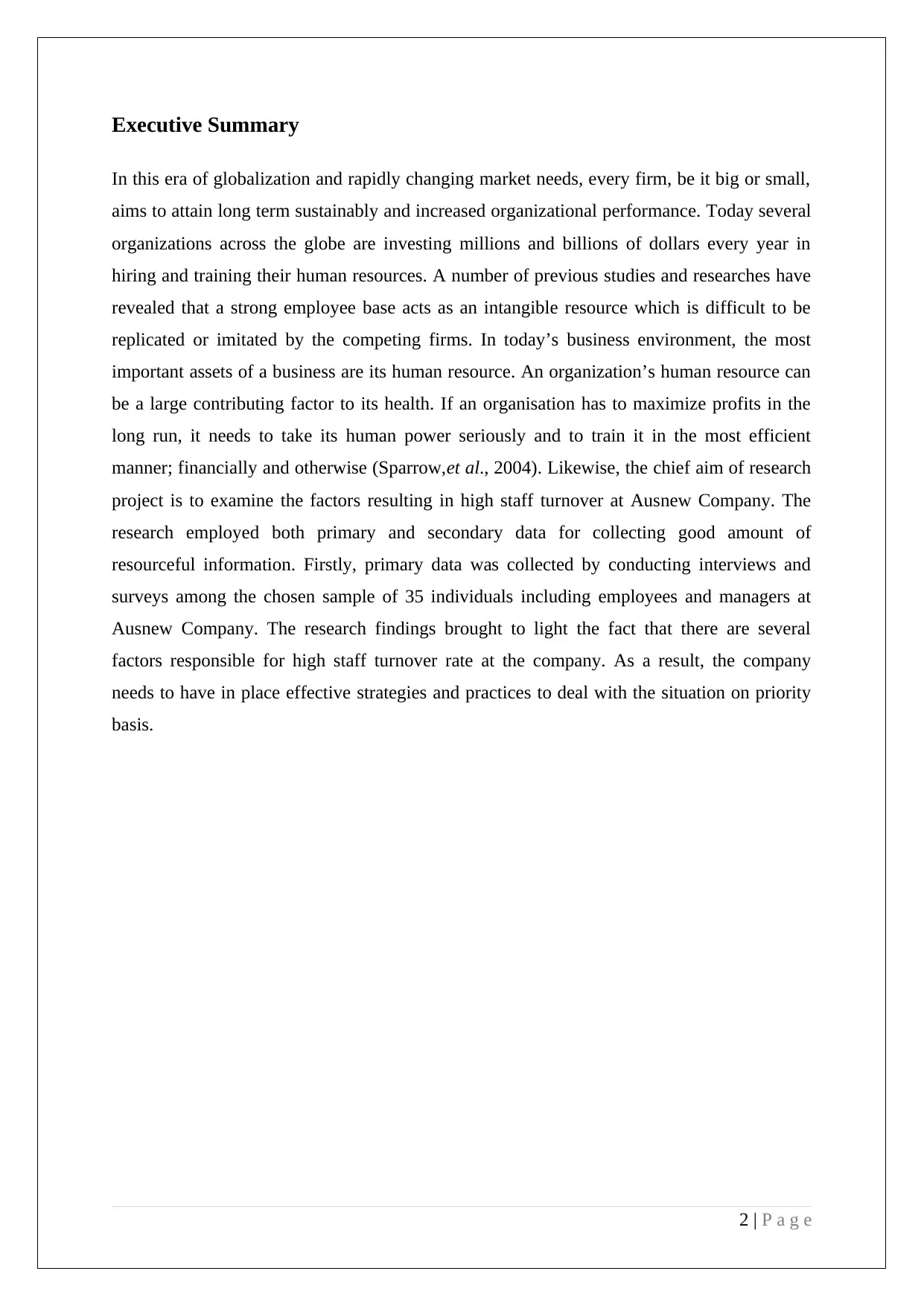
Executive Summary
In this era of globalization and rapidly changing market needs, every firm, be it big or small,
aims to attain long term sustainably and increased organizational performance. Today several
organizations across the globe are investing millions and billions of dollars every year in
hiring and training their human resources. A number of previous studies and researches have
revealed that a strong employee base acts as an intangible resource which is difficult to be
replicated or imitated by the competing firms. In today’s business environment, the most
important assets of a business are its human resource. An organization’s human resource can
be a large contributing factor to its health. If an organisation has to maximize profits in the
long run, it needs to take its human power seriously and to train it in the most efficient
manner; financially and otherwise (Sparrow,et al., 2004). Likewise, the chief aim of research
project is to examine the factors resulting in high staff turnover at Ausnew Company. The
research employed both primary and secondary data for collecting good amount of
resourceful information. Firstly, primary data was collected by conducting interviews and
surveys among the chosen sample of 35 individuals including employees and managers at
Ausnew Company. The research findings brought to light the fact that there are several
factors responsible for high staff turnover rate at the company. As a result, the company
needs to have in place effective strategies and practices to deal with the situation on priority
basis.
2 | P a g e
In this era of globalization and rapidly changing market needs, every firm, be it big or small,
aims to attain long term sustainably and increased organizational performance. Today several
organizations across the globe are investing millions and billions of dollars every year in
hiring and training their human resources. A number of previous studies and researches have
revealed that a strong employee base acts as an intangible resource which is difficult to be
replicated or imitated by the competing firms. In today’s business environment, the most
important assets of a business are its human resource. An organization’s human resource can
be a large contributing factor to its health. If an organisation has to maximize profits in the
long run, it needs to take its human power seriously and to train it in the most efficient
manner; financially and otherwise (Sparrow,et al., 2004). Likewise, the chief aim of research
project is to examine the factors resulting in high staff turnover at Ausnew Company. The
research employed both primary and secondary data for collecting good amount of
resourceful information. Firstly, primary data was collected by conducting interviews and
surveys among the chosen sample of 35 individuals including employees and managers at
Ausnew Company. The research findings brought to light the fact that there are several
factors responsible for high staff turnover rate at the company. As a result, the company
needs to have in place effective strategies and practices to deal with the situation on priority
basis.
2 | P a g e
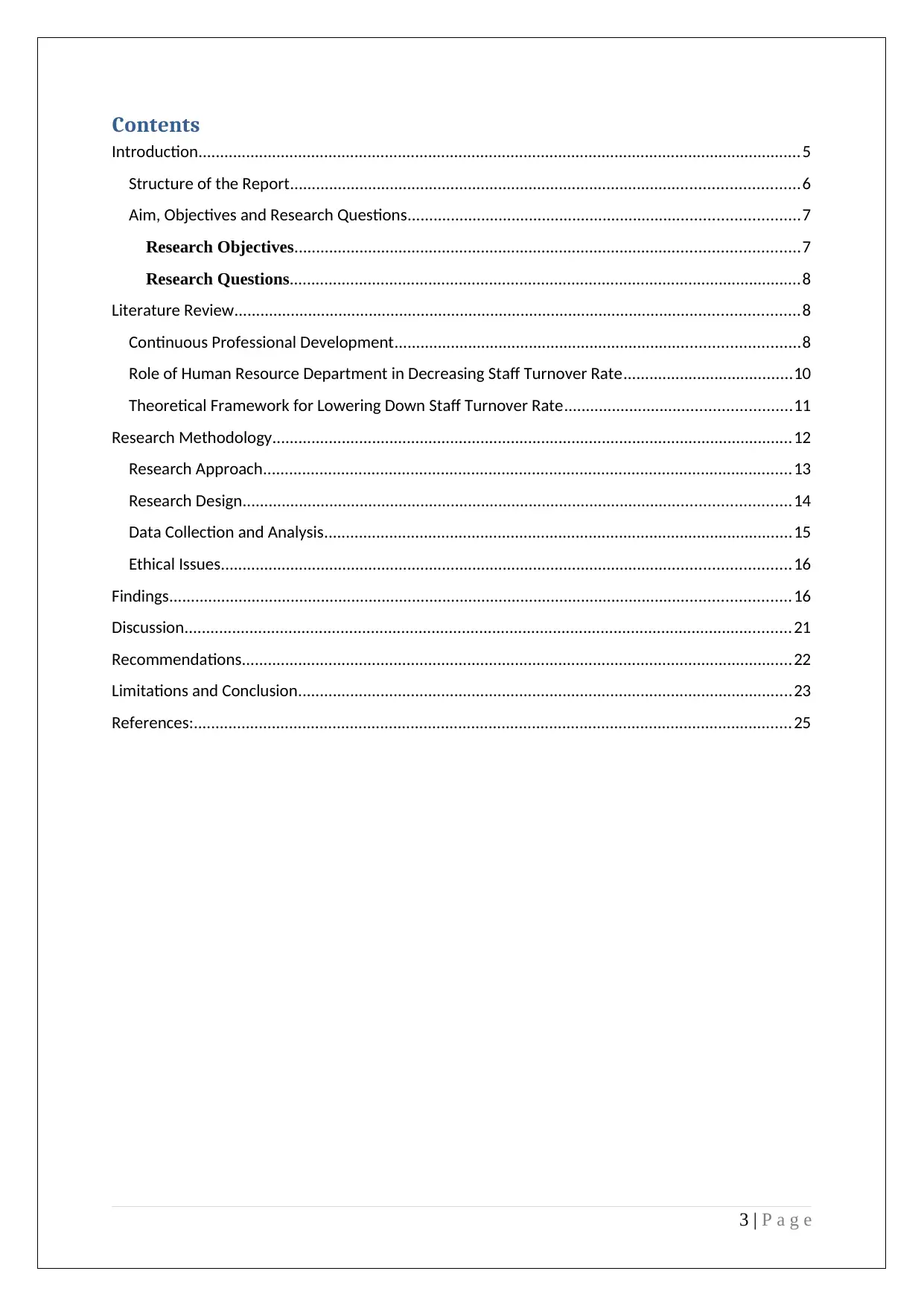
Contents
Introduction...........................................................................................................................................5
Structure of the Report.....................................................................................................................6
Aim, Objectives and Research Questions..........................................................................................7
Research Objectives....................................................................................................................7
Research Questions......................................................................................................................8
Literature Review..................................................................................................................................8
Continuous Professional Development.............................................................................................8
Role of Human Resource Department in Decreasing Staff Turnover Rate.......................................10
Theoretical Framework for Lowering Down Staff Turnover Rate....................................................11
Research Methodology........................................................................................................................12
Research Approach..........................................................................................................................13
Research Design..............................................................................................................................14
Data Collection and Analysis............................................................................................................15
Ethical Issues...................................................................................................................................16
Findings...............................................................................................................................................16
Discussion............................................................................................................................................21
Recommendations...............................................................................................................................22
Limitations and Conclusion..................................................................................................................23
References:..........................................................................................................................................25
3 | P a g e
Introduction...........................................................................................................................................5
Structure of the Report.....................................................................................................................6
Aim, Objectives and Research Questions..........................................................................................7
Research Objectives....................................................................................................................7
Research Questions......................................................................................................................8
Literature Review..................................................................................................................................8
Continuous Professional Development.............................................................................................8
Role of Human Resource Department in Decreasing Staff Turnover Rate.......................................10
Theoretical Framework for Lowering Down Staff Turnover Rate....................................................11
Research Methodology........................................................................................................................12
Research Approach..........................................................................................................................13
Research Design..............................................................................................................................14
Data Collection and Analysis............................................................................................................15
Ethical Issues...................................................................................................................................16
Findings...............................................................................................................................................16
Discussion............................................................................................................................................21
Recommendations...............................................................................................................................22
Limitations and Conclusion..................................................................................................................23
References:..........................................................................................................................................25
3 | P a g e
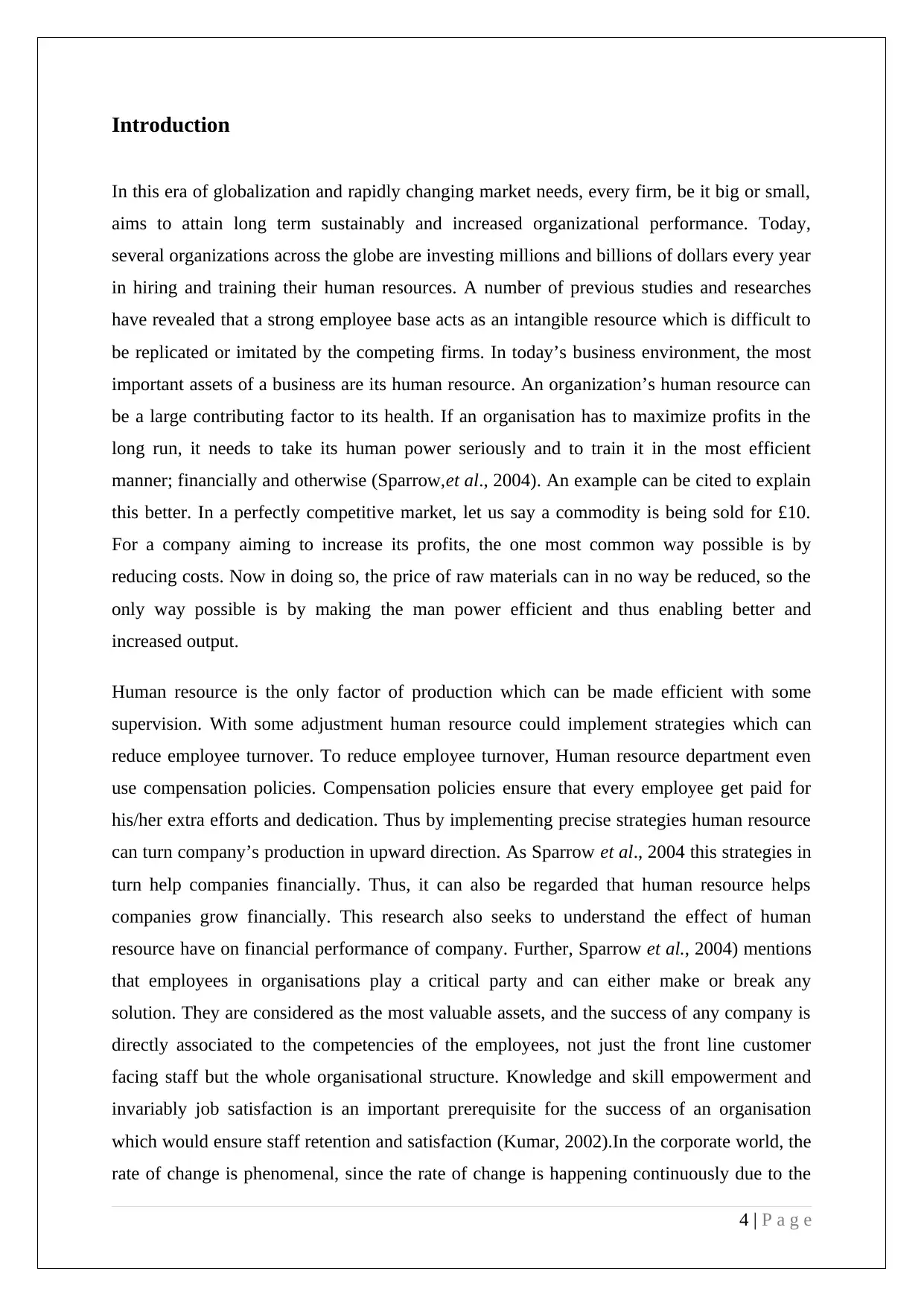
Introduction
In this era of globalization and rapidly changing market needs, every firm, be it big or small,
aims to attain long term sustainably and increased organizational performance. Today,
several organizations across the globe are investing millions and billions of dollars every year
in hiring and training their human resources. A number of previous studies and researches
have revealed that a strong employee base acts as an intangible resource which is difficult to
be replicated or imitated by the competing firms. In today’s business environment, the most
important assets of a business are its human resource. An organization’s human resource can
be a large contributing factor to its health. If an organisation has to maximize profits in the
long run, it needs to take its human power seriously and to train it in the most efficient
manner; financially and otherwise (Sparrow,et al., 2004). An example can be cited to explain
this better. In a perfectly competitive market, let us say a commodity is being sold for £10.
For a company aiming to increase its profits, the one most common way possible is by
reducing costs. Now in doing so, the price of raw materials can in no way be reduced, so the
only way possible is by making the man power efficient and thus enabling better and
increased output.
Human resource is the only factor of production which can be made efficient with some
supervision. With some adjustment human resource could implement strategies which can
reduce employee turnover. To reduce employee turnover, Human resource department even
use compensation policies. Compensation policies ensure that every employee get paid for
his/her extra efforts and dedication. Thus by implementing precise strategies human resource
can turn company’s production in upward direction. As Sparrow et al., 2004 this strategies in
turn help companies financially. Thus, it can also be regarded that human resource helps
companies grow financially. This research also seeks to understand the effect of human
resource have on financial performance of company. Further, Sparrow et al., 2004) mentions
that employees in organisations play a critical party and can either make or break any
solution. They are considered as the most valuable assets, and the success of any company is
directly associated to the competencies of the employees, not just the front line customer
facing staff but the whole organisational structure. Knowledge and skill empowerment and
invariably job satisfaction is an important prerequisite for the success of an organisation
which would ensure staff retention and satisfaction (Kumar, 2002).In the corporate world, the
rate of change is phenomenal, since the rate of change is happening continuously due to the
4 | P a g e
In this era of globalization and rapidly changing market needs, every firm, be it big or small,
aims to attain long term sustainably and increased organizational performance. Today,
several organizations across the globe are investing millions and billions of dollars every year
in hiring and training their human resources. A number of previous studies and researches
have revealed that a strong employee base acts as an intangible resource which is difficult to
be replicated or imitated by the competing firms. In today’s business environment, the most
important assets of a business are its human resource. An organization’s human resource can
be a large contributing factor to its health. If an organisation has to maximize profits in the
long run, it needs to take its human power seriously and to train it in the most efficient
manner; financially and otherwise (Sparrow,et al., 2004). An example can be cited to explain
this better. In a perfectly competitive market, let us say a commodity is being sold for £10.
For a company aiming to increase its profits, the one most common way possible is by
reducing costs. Now in doing so, the price of raw materials can in no way be reduced, so the
only way possible is by making the man power efficient and thus enabling better and
increased output.
Human resource is the only factor of production which can be made efficient with some
supervision. With some adjustment human resource could implement strategies which can
reduce employee turnover. To reduce employee turnover, Human resource department even
use compensation policies. Compensation policies ensure that every employee get paid for
his/her extra efforts and dedication. Thus by implementing precise strategies human resource
can turn company’s production in upward direction. As Sparrow et al., 2004 this strategies in
turn help companies financially. Thus, it can also be regarded that human resource helps
companies grow financially. This research also seeks to understand the effect of human
resource have on financial performance of company. Further, Sparrow et al., 2004) mentions
that employees in organisations play a critical party and can either make or break any
solution. They are considered as the most valuable assets, and the success of any company is
directly associated to the competencies of the employees, not just the front line customer
facing staff but the whole organisational structure. Knowledge and skill empowerment and
invariably job satisfaction is an important prerequisite for the success of an organisation
which would ensure staff retention and satisfaction (Kumar, 2002).In the corporate world, the
rate of change is phenomenal, since the rate of change is happening continuously due to the
4 | P a g e
Secure Best Marks with AI Grader
Need help grading? Try our AI Grader for instant feedback on your assignments.
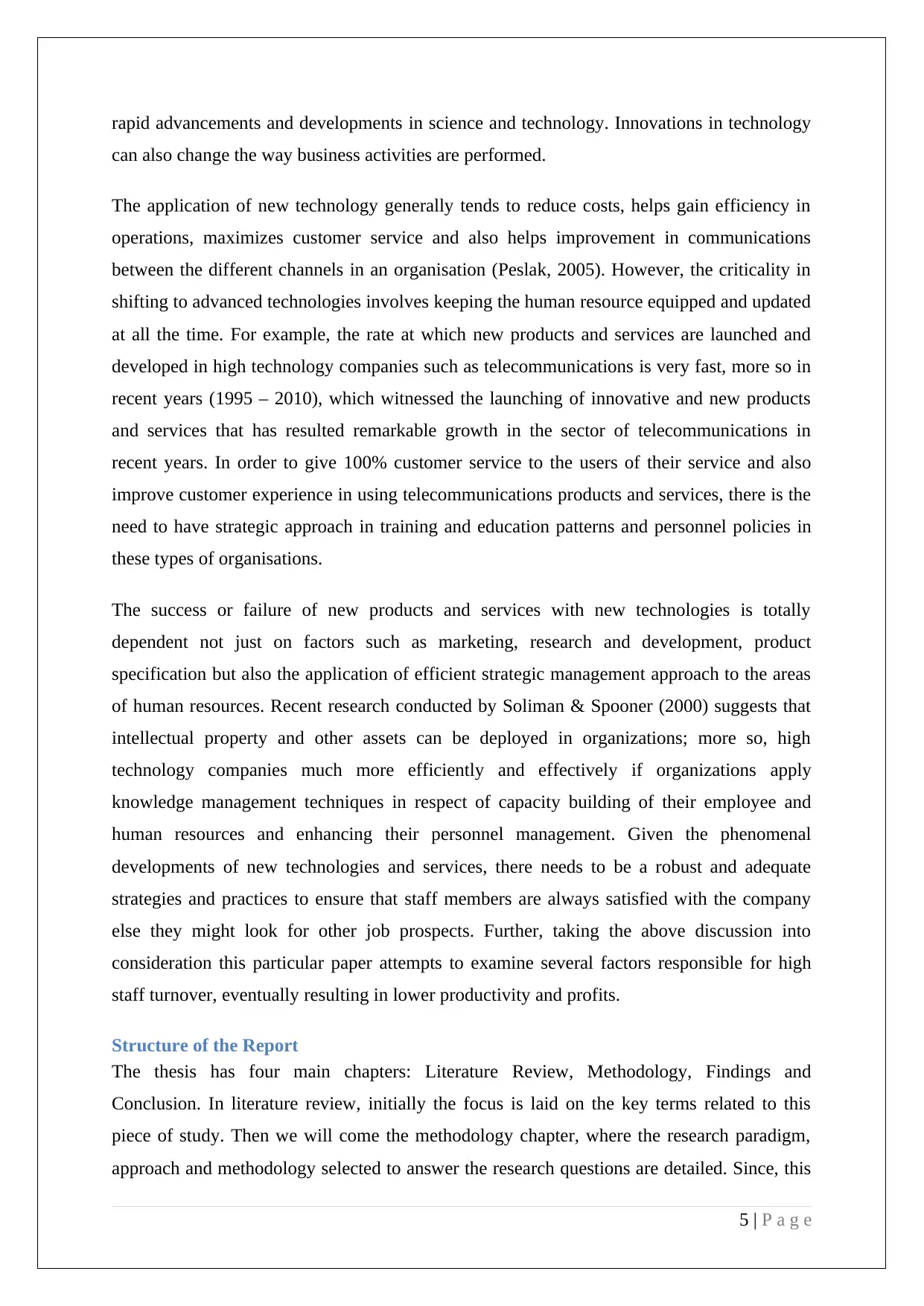
rapid advancements and developments in science and technology. Innovations in technology
can also change the way business activities are performed.
The application of new technology generally tends to reduce costs, helps gain efficiency in
operations, maximizes customer service and also helps improvement in communications
between the different channels in an organisation (Peslak, 2005). However, the criticality in
shifting to advanced technologies involves keeping the human resource equipped and updated
at all the time. For example, the rate at which new products and services are launched and
developed in high technology companies such as telecommunications is very fast, more so in
recent years (1995 – 2010), which witnessed the launching of innovative and new products
and services that has resulted remarkable growth in the sector of telecommunications in
recent years. In order to give 100% customer service to the users of their service and also
improve customer experience in using telecommunications products and services, there is the
need to have strategic approach in training and education patterns and personnel policies in
these types of organisations.
The success or failure of new products and services with new technologies is totally
dependent not just on factors such as marketing, research and development, product
specification but also the application of efficient strategic management approach to the areas
of human resources. Recent research conducted by Soliman & Spooner (2000) suggests that
intellectual property and other assets can be deployed in organizations; more so, high
technology companies much more efficiently and effectively if organizations apply
knowledge management techniques in respect of capacity building of their employee and
human resources and enhancing their personnel management. Given the phenomenal
developments of new technologies and services, there needs to be a robust and adequate
strategies and practices to ensure that staff members are always satisfied with the company
else they might look for other job prospects. Further, taking the above discussion into
consideration this particular paper attempts to examine several factors responsible for high
staff turnover, eventually resulting in lower productivity and profits.
Structure of the Report
The thesis has four main chapters: Literature Review, Methodology, Findings and
Conclusion. In literature review, initially the focus is laid on the key terms related to this
piece of study. Then we will come the methodology chapter, where the research paradigm,
approach and methodology selected to answer the research questions are detailed. Since, this
5 | P a g e
can also change the way business activities are performed.
The application of new technology generally tends to reduce costs, helps gain efficiency in
operations, maximizes customer service and also helps improvement in communications
between the different channels in an organisation (Peslak, 2005). However, the criticality in
shifting to advanced technologies involves keeping the human resource equipped and updated
at all the time. For example, the rate at which new products and services are launched and
developed in high technology companies such as telecommunications is very fast, more so in
recent years (1995 – 2010), which witnessed the launching of innovative and new products
and services that has resulted remarkable growth in the sector of telecommunications in
recent years. In order to give 100% customer service to the users of their service and also
improve customer experience in using telecommunications products and services, there is the
need to have strategic approach in training and education patterns and personnel policies in
these types of organisations.
The success or failure of new products and services with new technologies is totally
dependent not just on factors such as marketing, research and development, product
specification but also the application of efficient strategic management approach to the areas
of human resources. Recent research conducted by Soliman & Spooner (2000) suggests that
intellectual property and other assets can be deployed in organizations; more so, high
technology companies much more efficiently and effectively if organizations apply
knowledge management techniques in respect of capacity building of their employee and
human resources and enhancing their personnel management. Given the phenomenal
developments of new technologies and services, there needs to be a robust and adequate
strategies and practices to ensure that staff members are always satisfied with the company
else they might look for other job prospects. Further, taking the above discussion into
consideration this particular paper attempts to examine several factors responsible for high
staff turnover, eventually resulting in lower productivity and profits.
Structure of the Report
The thesis has four main chapters: Literature Review, Methodology, Findings and
Conclusion. In literature review, initially the focus is laid on the key terms related to this
piece of study. Then we will come the methodology chapter, where the research paradigm,
approach and methodology selected to answer the research questions are detailed. Since, this
5 | P a g e
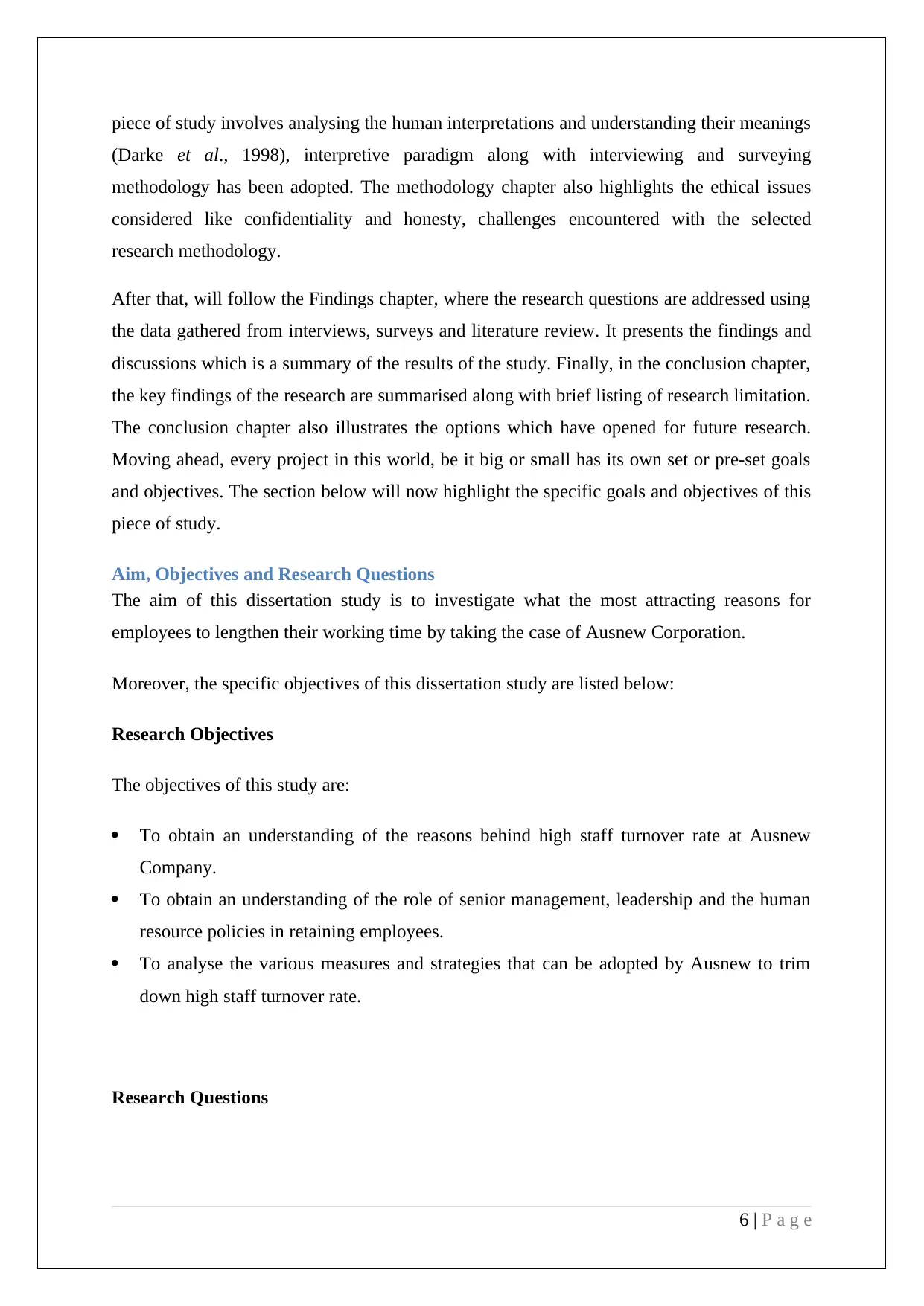
piece of study involves analysing the human interpretations and understanding their meanings
(Darke et al., 1998), interpretive paradigm along with interviewing and surveying
methodology has been adopted. The methodology chapter also highlights the ethical issues
considered like confidentiality and honesty, challenges encountered with the selected
research methodology.
After that, will follow the Findings chapter, where the research questions are addressed using
the data gathered from interviews, surveys and literature review. It presents the findings and
discussions which is a summary of the results of the study. Finally, in the conclusion chapter,
the key findings of the research are summarised along with brief listing of research limitation.
The conclusion chapter also illustrates the options which have opened for future research.
Moving ahead, every project in this world, be it big or small has its own set or pre-set goals
and objectives. The section below will now highlight the specific goals and objectives of this
piece of study.
Aim, Objectives and Research Questions
The aim of this dissertation study is to investigate what the most attracting reasons for
employees to lengthen their working time by taking the case of Ausnew Corporation.
Moreover, the specific objectives of this dissertation study are listed below:
Research Objectives
The objectives of this study are:
To obtain an understanding of the reasons behind high staff turnover rate at Ausnew
Company.
To obtain an understanding of the role of senior management, leadership and the human
resource policies in retaining employees.
To analyse the various measures and strategies that can be adopted by Ausnew to trim
down high staff turnover rate.
Research Questions
6 | P a g e
(Darke et al., 1998), interpretive paradigm along with interviewing and surveying
methodology has been adopted. The methodology chapter also highlights the ethical issues
considered like confidentiality and honesty, challenges encountered with the selected
research methodology.
After that, will follow the Findings chapter, where the research questions are addressed using
the data gathered from interviews, surveys and literature review. It presents the findings and
discussions which is a summary of the results of the study. Finally, in the conclusion chapter,
the key findings of the research are summarised along with brief listing of research limitation.
The conclusion chapter also illustrates the options which have opened for future research.
Moving ahead, every project in this world, be it big or small has its own set or pre-set goals
and objectives. The section below will now highlight the specific goals and objectives of this
piece of study.
Aim, Objectives and Research Questions
The aim of this dissertation study is to investigate what the most attracting reasons for
employees to lengthen their working time by taking the case of Ausnew Corporation.
Moreover, the specific objectives of this dissertation study are listed below:
Research Objectives
The objectives of this study are:
To obtain an understanding of the reasons behind high staff turnover rate at Ausnew
Company.
To obtain an understanding of the role of senior management, leadership and the human
resource policies in retaining employees.
To analyse the various measures and strategies that can be adopted by Ausnew to trim
down high staff turnover rate.
Research Questions
6 | P a g e
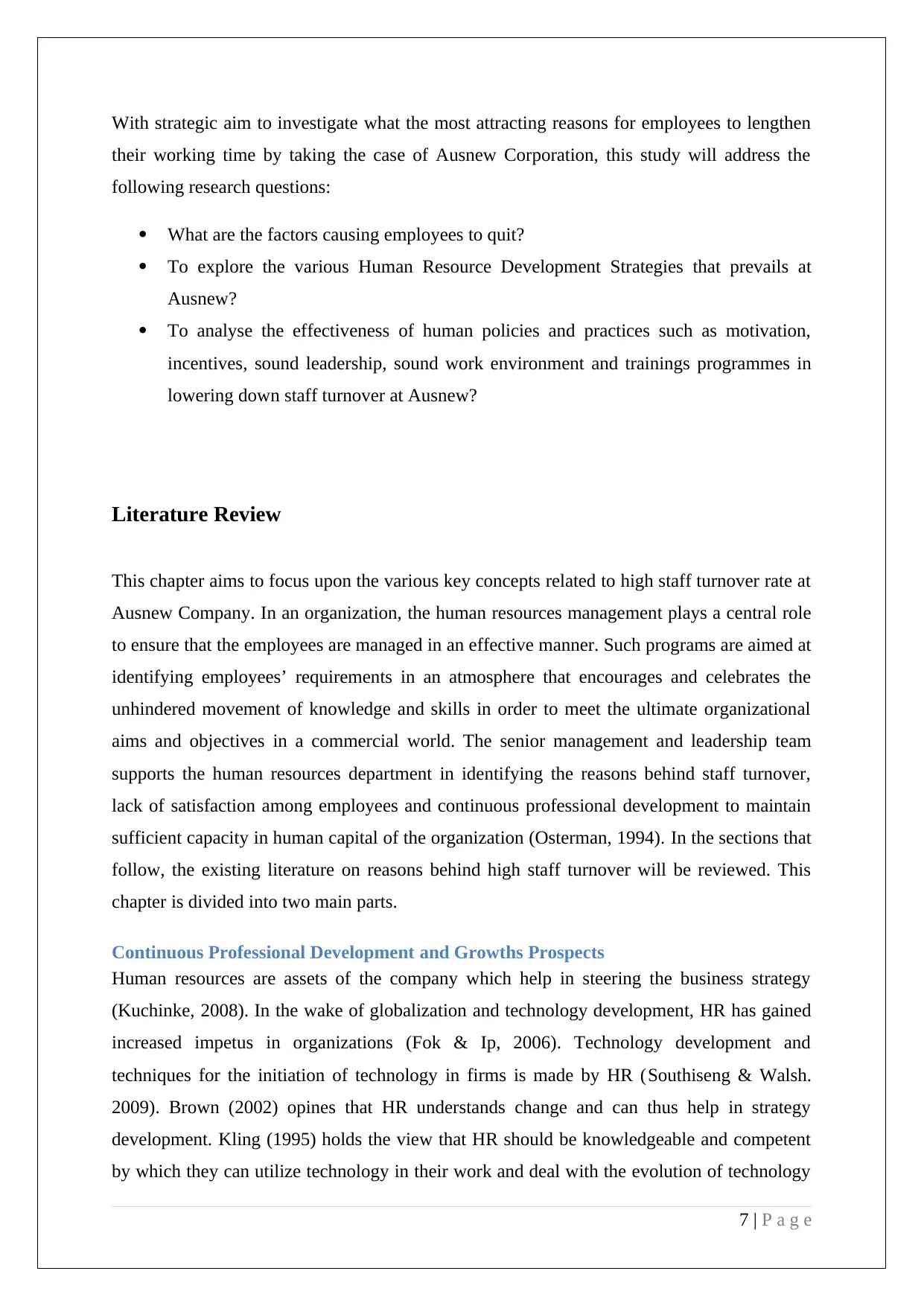
With strategic aim to investigate what the most attracting reasons for employees to lengthen
their working time by taking the case of Ausnew Corporation, this study will address the
following research questions:
What are the factors causing employees to quit?
To explore the various Human Resource Development Strategies that prevails at
Ausnew?
To analyse the effectiveness of human policies and practices such as motivation,
incentives, sound leadership, sound work environment and trainings programmes in
lowering down staff turnover at Ausnew?
Literature Review
This chapter aims to focus upon the various key concepts related to high staff turnover rate at
Ausnew Company. In an organization, the human resources management plays a central role
to ensure that the employees are managed in an effective manner. Such programs are aimed at
identifying employees’ requirements in an atmosphere that encourages and celebrates the
unhindered movement of knowledge and skills in order to meet the ultimate organizational
aims and objectives in a commercial world. The senior management and leadership team
supports the human resources department in identifying the reasons behind staff turnover,
lack of satisfaction among employees and continuous professional development to maintain
sufficient capacity in human capital of the organization (Osterman, 1994). In the sections that
follow, the existing literature on reasons behind high staff turnover will be reviewed. This
chapter is divided into two main parts.
Continuous Professional Development and Growths Prospects
Human resources are assets of the company which help in steering the business strategy
(Kuchinke, 2008). In the wake of globalization and technology development, HR has gained
increased impetus in organizations (Fok & Ip, 2006). Technology development and
techniques for the initiation of technology in firms is made by HR (Southiseng & Walsh.
2009). Brown (2002) opines that HR understands change and can thus help in strategy
development. Kling (1995) holds the view that HR should be knowledgeable and competent
by which they can utilize technology in their work and deal with the evolution of technology
7 | P a g e
their working time by taking the case of Ausnew Corporation, this study will address the
following research questions:
What are the factors causing employees to quit?
To explore the various Human Resource Development Strategies that prevails at
Ausnew?
To analyse the effectiveness of human policies and practices such as motivation,
incentives, sound leadership, sound work environment and trainings programmes in
lowering down staff turnover at Ausnew?
Literature Review
This chapter aims to focus upon the various key concepts related to high staff turnover rate at
Ausnew Company. In an organization, the human resources management plays a central role
to ensure that the employees are managed in an effective manner. Such programs are aimed at
identifying employees’ requirements in an atmosphere that encourages and celebrates the
unhindered movement of knowledge and skills in order to meet the ultimate organizational
aims and objectives in a commercial world. The senior management and leadership team
supports the human resources department in identifying the reasons behind staff turnover,
lack of satisfaction among employees and continuous professional development to maintain
sufficient capacity in human capital of the organization (Osterman, 1994). In the sections that
follow, the existing literature on reasons behind high staff turnover will be reviewed. This
chapter is divided into two main parts.
Continuous Professional Development and Growths Prospects
Human resources are assets of the company which help in steering the business strategy
(Kuchinke, 2008). In the wake of globalization and technology development, HR has gained
increased impetus in organizations (Fok & Ip, 2006). Technology development and
techniques for the initiation of technology in firms is made by HR (Southiseng & Walsh.
2009). Brown (2002) opines that HR understands change and can thus help in strategy
development. Kling (1995) holds the view that HR should be knowledgeable and competent
by which they can utilize technology in their work and deal with the evolution of technology
7 | P a g e
Paraphrase This Document
Need a fresh take? Get an instant paraphrase of this document with our AI Paraphraser
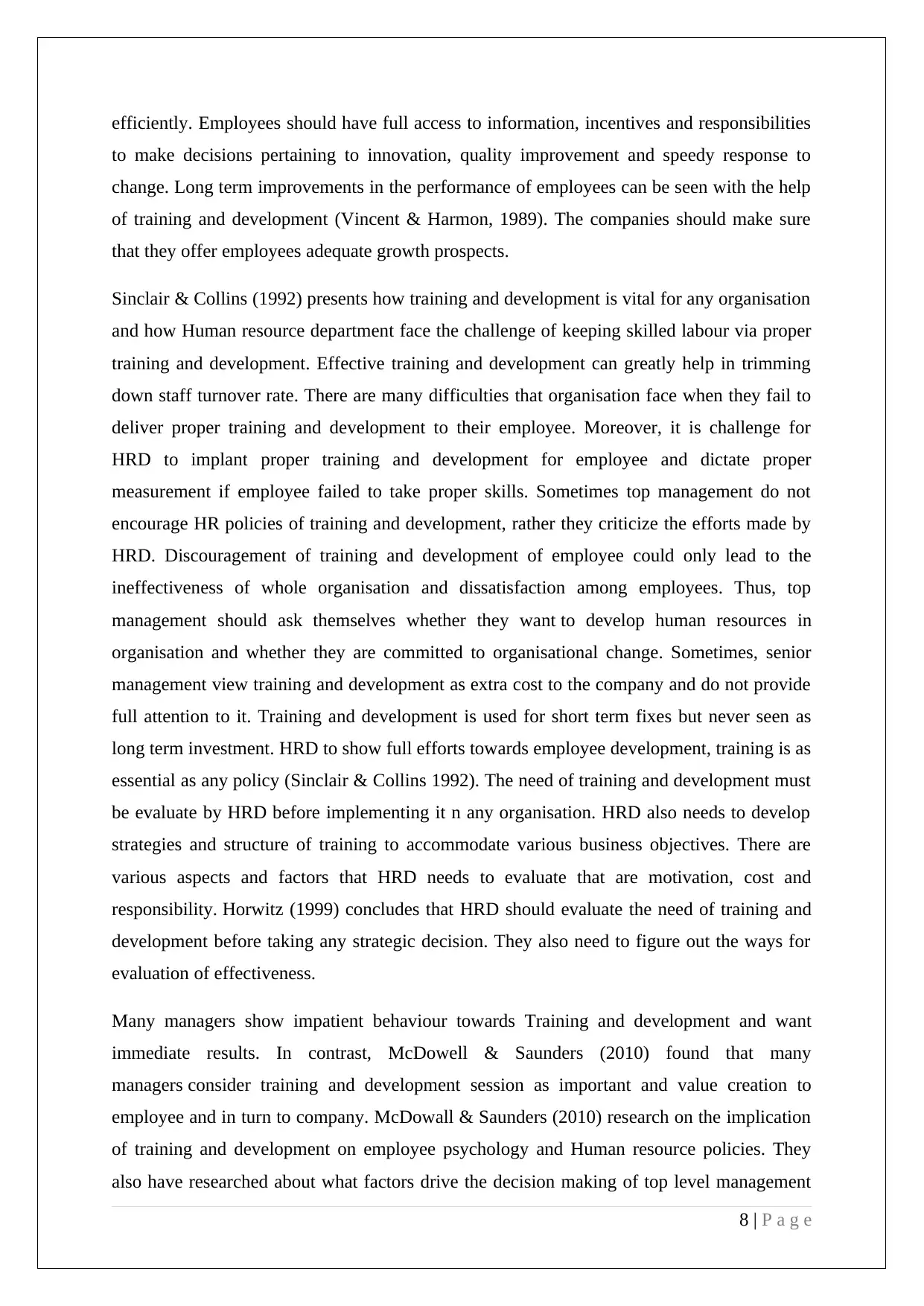
efficiently. Employees should have full access to information, incentives and responsibilities
to make decisions pertaining to innovation, quality improvement and speedy response to
change. Long term improvements in the performance of employees can be seen with the help
of training and development (Vincent & Harmon, 1989). The companies should make sure
that they offer employees adequate growth prospects.
Sinclair & Collins (1992) presents how training and development is vital for any organisation
and how Human resource department face the challenge of keeping skilled labour via proper
training and development. Effective training and development can greatly help in trimming
down staff turnover rate. There are many difficulties that organisation face when they fail to
deliver proper training and development to their employee. Moreover, it is challenge for
HRD to implant proper training and development for employee and dictate proper
measurement if employee failed to take proper skills. Sometimes top management do not
encourage HR policies of training and development, rather they criticize the efforts made by
HRD. Discouragement of training and development of employee could only lead to the
ineffectiveness of whole organisation and dissatisfaction among employees. Thus, top
management should ask themselves whether they want to develop human resources in
organisation and whether they are committed to organisational change. Sometimes, senior
management view training and development as extra cost to the company and do not provide
full attention to it. Training and development is used for short term fixes but never seen as
long term investment. HRD to show full efforts towards employee development, training is as
essential as any policy (Sinclair & Collins 1992). The need of training and development must
be evaluate by HRD before implementing it n any organisation. HRD also needs to develop
strategies and structure of training to accommodate various business objectives. There are
various aspects and factors that HRD needs to evaluate that are motivation, cost and
responsibility. Horwitz (1999) concludes that HRD should evaluate the need of training and
development before taking any strategic decision. They also need to figure out the ways for
evaluation of effectiveness.
Many managers show impatient behaviour towards Training and development and want
immediate results. In contrast, McDowell & Saunders (2010) found that many
managers consider training and development session as important and value creation to
employee and in turn to company. McDowall & Saunders (2010) research on the implication
of training and development on employee psychology and Human resource policies. They
also have researched about what factors drive the decision making of top level management
8 | P a g e
to make decisions pertaining to innovation, quality improvement and speedy response to
change. Long term improvements in the performance of employees can be seen with the help
of training and development (Vincent & Harmon, 1989). The companies should make sure
that they offer employees adequate growth prospects.
Sinclair & Collins (1992) presents how training and development is vital for any organisation
and how Human resource department face the challenge of keeping skilled labour via proper
training and development. Effective training and development can greatly help in trimming
down staff turnover rate. There are many difficulties that organisation face when they fail to
deliver proper training and development to their employee. Moreover, it is challenge for
HRD to implant proper training and development for employee and dictate proper
measurement if employee failed to take proper skills. Sometimes top management do not
encourage HR policies of training and development, rather they criticize the efforts made by
HRD. Discouragement of training and development of employee could only lead to the
ineffectiveness of whole organisation and dissatisfaction among employees. Thus, top
management should ask themselves whether they want to develop human resources in
organisation and whether they are committed to organisational change. Sometimes, senior
management view training and development as extra cost to the company and do not provide
full attention to it. Training and development is used for short term fixes but never seen as
long term investment. HRD to show full efforts towards employee development, training is as
essential as any policy (Sinclair & Collins 1992). The need of training and development must
be evaluate by HRD before implementing it n any organisation. HRD also needs to develop
strategies and structure of training to accommodate various business objectives. There are
various aspects and factors that HRD needs to evaluate that are motivation, cost and
responsibility. Horwitz (1999) concludes that HRD should evaluate the need of training and
development before taking any strategic decision. They also need to figure out the ways for
evaluation of effectiveness.
Many managers show impatient behaviour towards Training and development and want
immediate results. In contrast, McDowell & Saunders (2010) found that many
managers consider training and development session as important and value creation to
employee and in turn to company. McDowall & Saunders (2010) research on the implication
of training and development on employee psychology and Human resource policies. They
also have researched about what factors drive the decision making of top level management
8 | P a g e

to go for training and development. They also found out relation between firm performance
and training and development. The most effective training and development process is
tangible demonstration of training and development. The tangible demonstration perceived as
return on investment method and hence it widely used.
Role of Motivation and Sound leadership in Decreasing Staff Turnover Rate
Sound leadership and motivation have been largely involved in capability building of
employees in several organizations. The focus of the company must be laid on ensuring that
the employees are regularly motivated and directed by an effective leader. Sound leadership
functions have a wide range of activities including Knowledge Management, training and
development, motivation and rewards (Braganza, 2001). It can be a source of sustained
competitive advantage for a company as it helps to improve organizational performance,
solve problems and deal with high staff turnover. Moreover, it is often perceived that Sound
leadership and motivation is vital in organisation with higher employment like any
technological firm. Some of the very well-known policies for the higher company
performance are high commitment towards employee and specialization of workplaces to
achieve flexibility (Osterman 1994). If organisations follow these policies, they can achieve
higher team performance. Hence, the company results are lot more dependent on successful
implementation of these HR policies.
d'Arcimoles (1997) has raised concern as to how effective HR polices and practices result in
highly satisfied employees and low staff turnover. d'Arcimoles (1997) has studied various
concerns about Human resource policies and tried to find solutions for the same. He has
found that there is some relationship between the key indicators of HR policies with
employees’ performance and satisfaction level. Those key indicators are listed as 1) training
for the employee to create skilled employee force. The author has clearly found direct
relation between employee training and turnover rate. The second key indicator is recovery
effects which can be used for company performance judgement. Research paper also finds
out the key obstacle in implementing HR policies for company benefits. Key obstacle in full
implementation of HR policies is shareholder interest or lack of it. Shareholders are very
reluctant to follow some stringent HR policies that could benefit organisation for long run.
Instead they are very conservative in their approach and require some strong leadership push
from senior management.
9 | P a g e
and training and development. The most effective training and development process is
tangible demonstration of training and development. The tangible demonstration perceived as
return on investment method and hence it widely used.
Role of Motivation and Sound leadership in Decreasing Staff Turnover Rate
Sound leadership and motivation have been largely involved in capability building of
employees in several organizations. The focus of the company must be laid on ensuring that
the employees are regularly motivated and directed by an effective leader. Sound leadership
functions have a wide range of activities including Knowledge Management, training and
development, motivation and rewards (Braganza, 2001). It can be a source of sustained
competitive advantage for a company as it helps to improve organizational performance,
solve problems and deal with high staff turnover. Moreover, it is often perceived that Sound
leadership and motivation is vital in organisation with higher employment like any
technological firm. Some of the very well-known policies for the higher company
performance are high commitment towards employee and specialization of workplaces to
achieve flexibility (Osterman 1994). If organisations follow these policies, they can achieve
higher team performance. Hence, the company results are lot more dependent on successful
implementation of these HR policies.
d'Arcimoles (1997) has raised concern as to how effective HR polices and practices result in
highly satisfied employees and low staff turnover. d'Arcimoles (1997) has studied various
concerns about Human resource policies and tried to find solutions for the same. He has
found that there is some relationship between the key indicators of HR policies with
employees’ performance and satisfaction level. Those key indicators are listed as 1) training
for the employee to create skilled employee force. The author has clearly found direct
relation between employee training and turnover rate. The second key indicator is recovery
effects which can be used for company performance judgement. Research paper also finds
out the key obstacle in implementing HR policies for company benefits. Key obstacle in full
implementation of HR policies is shareholder interest or lack of it. Shareholders are very
reluctant to follow some stringent HR policies that could benefit organisation for long run.
Instead they are very conservative in their approach and require some strong leadership push
from senior management.
9 | P a g e
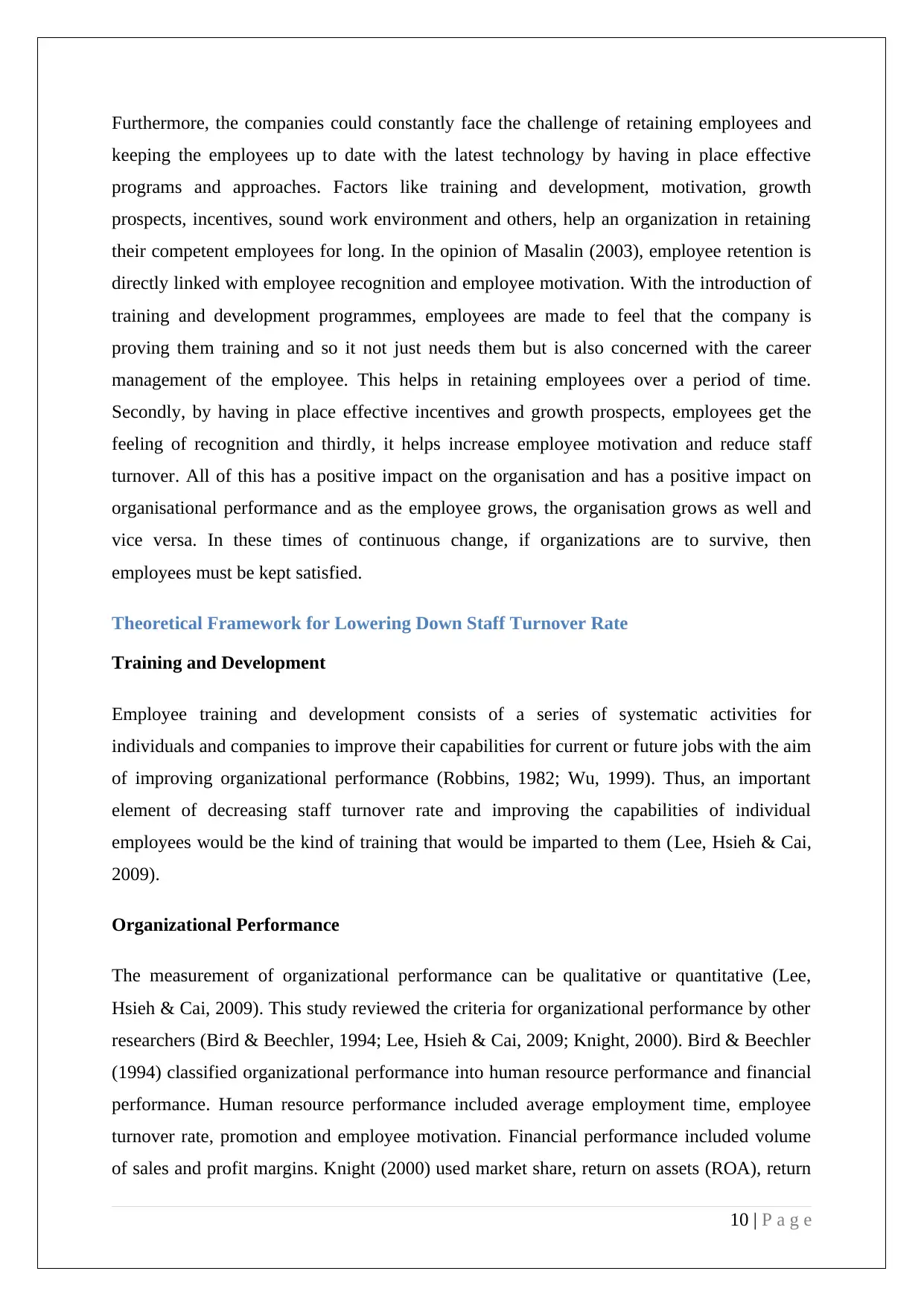
Furthermore, the companies could constantly face the challenge of retaining employees and
keeping the employees up to date with the latest technology by having in place effective
programs and approaches. Factors like training and development, motivation, growth
prospects, incentives, sound work environment and others, help an organization in retaining
their competent employees for long. In the opinion of Masalin (2003), employee retention is
directly linked with employee recognition and employee motivation. With the introduction of
training and development programmes, employees are made to feel that the company is
proving them training and so it not just needs them but is also concerned with the career
management of the employee. This helps in retaining employees over a period of time.
Secondly, by having in place effective incentives and growth prospects, employees get the
feeling of recognition and thirdly, it helps increase employee motivation and reduce staff
turnover. All of this has a positive impact on the organisation and has a positive impact on
organisational performance and as the employee grows, the organisation grows as well and
vice versa. In these times of continuous change, if organizations are to survive, then
employees must be kept satisfied.
Theoretical Framework for Lowering Down Staff Turnover Rate
Training and Development
Employee training and development consists of a series of systematic activities for
individuals and companies to improve their capabilities for current or future jobs with the aim
of improving organizational performance (Robbins, 1982; Wu, 1999). Thus, an important
element of decreasing staff turnover rate and improving the capabilities of individual
employees would be the kind of training that would be imparted to them (Lee, Hsieh & Cai,
2009).
Organizational Performance
The measurement of organizational performance can be qualitative or quantitative (Lee,
Hsieh & Cai, 2009). This study reviewed the criteria for organizational performance by other
researchers (Bird & Beechler, 1994; Lee, Hsieh & Cai, 2009; Knight, 2000). Bird & Beechler
(1994) classified organizational performance into human resource performance and financial
performance. Human resource performance included average employment time, employee
turnover rate, promotion and employee motivation. Financial performance included volume
of sales and profit margins. Knight (2000) used market share, return on assets (ROA), return
10 | P a g e
keeping the employees up to date with the latest technology by having in place effective
programs and approaches. Factors like training and development, motivation, growth
prospects, incentives, sound work environment and others, help an organization in retaining
their competent employees for long. In the opinion of Masalin (2003), employee retention is
directly linked with employee recognition and employee motivation. With the introduction of
training and development programmes, employees are made to feel that the company is
proving them training and so it not just needs them but is also concerned with the career
management of the employee. This helps in retaining employees over a period of time.
Secondly, by having in place effective incentives and growth prospects, employees get the
feeling of recognition and thirdly, it helps increase employee motivation and reduce staff
turnover. All of this has a positive impact on the organisation and has a positive impact on
organisational performance and as the employee grows, the organisation grows as well and
vice versa. In these times of continuous change, if organizations are to survive, then
employees must be kept satisfied.
Theoretical Framework for Lowering Down Staff Turnover Rate
Training and Development
Employee training and development consists of a series of systematic activities for
individuals and companies to improve their capabilities for current or future jobs with the aim
of improving organizational performance (Robbins, 1982; Wu, 1999). Thus, an important
element of decreasing staff turnover rate and improving the capabilities of individual
employees would be the kind of training that would be imparted to them (Lee, Hsieh & Cai,
2009).
Organizational Performance
The measurement of organizational performance can be qualitative or quantitative (Lee,
Hsieh & Cai, 2009). This study reviewed the criteria for organizational performance by other
researchers (Bird & Beechler, 1994; Lee, Hsieh & Cai, 2009; Knight, 2000). Bird & Beechler
(1994) classified organizational performance into human resource performance and financial
performance. Human resource performance included average employment time, employee
turnover rate, promotion and employee motivation. Financial performance included volume
of sales and profit margins. Knight (2000) used market share, return on assets (ROA), return
10 | P a g e
Secure Best Marks with AI Grader
Need help grading? Try our AI Grader for instant feedback on your assignments.
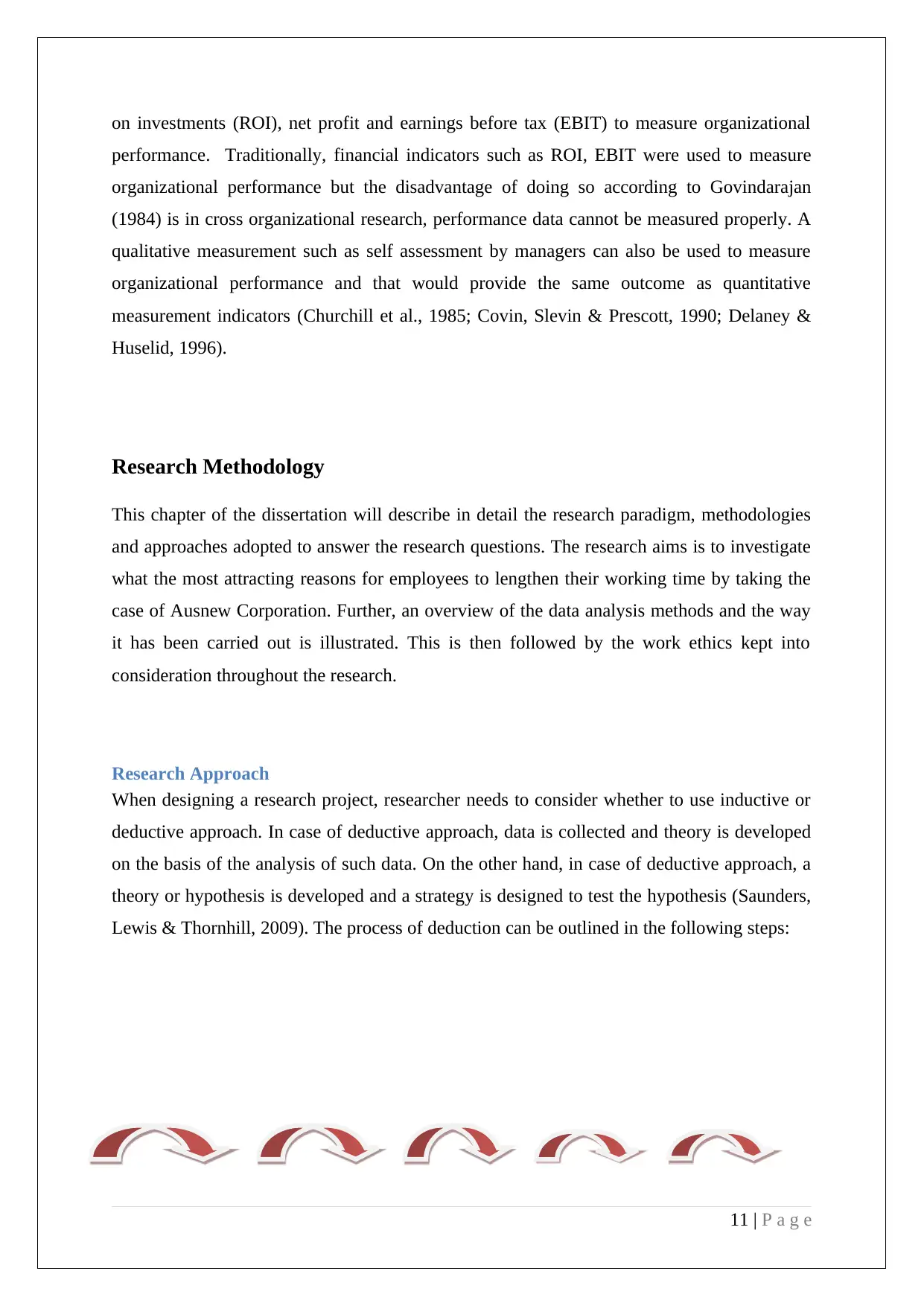
on investments (ROI), net profit and earnings before tax (EBIT) to measure organizational
performance. Traditionally, financial indicators such as ROI, EBIT were used to measure
organizational performance but the disadvantage of doing so according to Govindarajan
(1984) is in cross organizational research, performance data cannot be measured properly. A
qualitative measurement such as self assessment by managers can also be used to measure
organizational performance and that would provide the same outcome as quantitative
measurement indicators (Churchill et al., 1985; Covin, Slevin & Prescott, 1990; Delaney &
Huselid, 1996).
Research Methodology
This chapter of the dissertation will describe in detail the research paradigm, methodologies
and approaches adopted to answer the research questions. The research aims is to investigate
what the most attracting reasons for employees to lengthen their working time by taking the
case of Ausnew Corporation. Further, an overview of the data analysis methods and the way
it has been carried out is illustrated. This is then followed by the work ethics kept into
consideration throughout the research.
Research Approach
When designing a research project, researcher needs to consider whether to use inductive or
deductive approach. In case of deductive approach, data is collected and theory is developed
on the basis of the analysis of such data. On the other hand, in case of deductive approach, a
theory or hypothesis is developed and a strategy is designed to test the hypothesis (Saunders,
Lewis & Thornhill, 2009). The process of deduction can be outlined in the following steps:
11 | P a g e
performance. Traditionally, financial indicators such as ROI, EBIT were used to measure
organizational performance but the disadvantage of doing so according to Govindarajan
(1984) is in cross organizational research, performance data cannot be measured properly. A
qualitative measurement such as self assessment by managers can also be used to measure
organizational performance and that would provide the same outcome as quantitative
measurement indicators (Churchill et al., 1985; Covin, Slevin & Prescott, 1990; Delaney &
Huselid, 1996).
Research Methodology
This chapter of the dissertation will describe in detail the research paradigm, methodologies
and approaches adopted to answer the research questions. The research aims is to investigate
what the most attracting reasons for employees to lengthen their working time by taking the
case of Ausnew Corporation. Further, an overview of the data analysis methods and the way
it has been carried out is illustrated. This is then followed by the work ethics kept into
consideration throughout the research.
Research Approach
When designing a research project, researcher needs to consider whether to use inductive or
deductive approach. In case of deductive approach, data is collected and theory is developed
on the basis of the analysis of such data. On the other hand, in case of deductive approach, a
theory or hypothesis is developed and a strategy is designed to test the hypothesis (Saunders,
Lewis & Thornhill, 2009). The process of deduction can be outlined in the following steps:
11 | P a g e

Figure 1: The process of deduction (Adapted from Bryman & Bell, 2007, pp. 11)
12 | P a g e
Theory Hypothesis
Data
Collection Findings
Hypothesis
confirmed/
rejected
Revision
Of
12 | P a g e
Theory Hypothesis
Data
Collection Findings
Hypothesis
confirmed/
rejected
Revision
Of
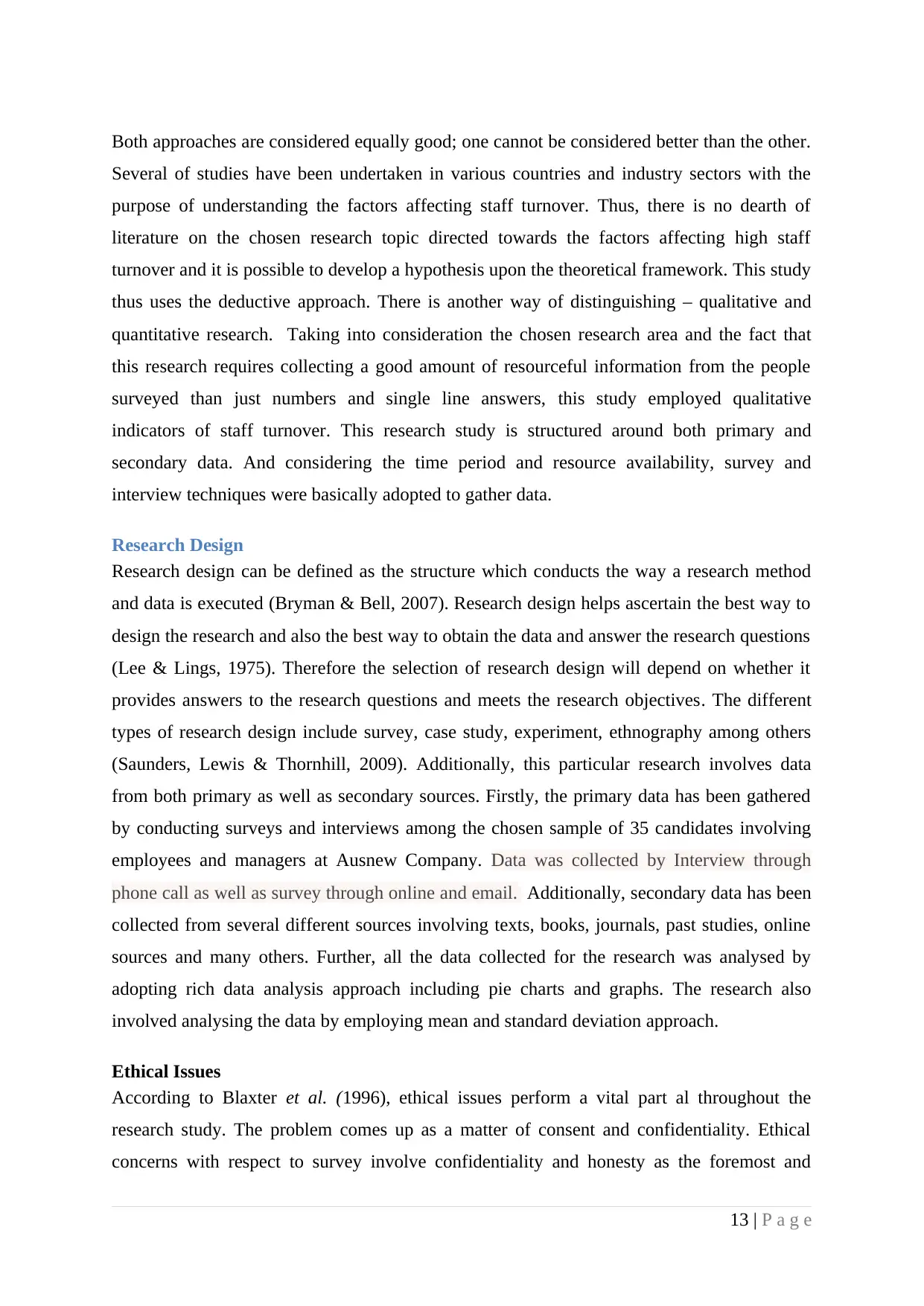
Both approaches are considered equally good; one cannot be considered better than the other.
Several of studies have been undertaken in various countries and industry sectors with the
purpose of understanding the factors affecting staff turnover. Thus, there is no dearth of
literature on the chosen research topic directed towards the factors affecting high staff
turnover and it is possible to develop a hypothesis upon the theoretical framework. This study
thus uses the deductive approach. There is another way of distinguishing – qualitative and
quantitative research. Taking into consideration the chosen research area and the fact that
this research requires collecting a good amount of resourceful information from the people
surveyed than just numbers and single line answers, this study employed qualitative
indicators of staff turnover. This research study is structured around both primary and
secondary data. And considering the time period and resource availability, survey and
interview techniques were basically adopted to gather data.
Research Design
Research design can be defined as the structure which conducts the way a research method
and data is executed (Bryman & Bell, 2007). Research design helps ascertain the best way to
design the research and also the best way to obtain the data and answer the research questions
(Lee & Lings, 1975). Therefore the selection of research design will depend on whether it
provides answers to the research questions and meets the research objectives. The different
types of research design include survey, case study, experiment, ethnography among others
(Saunders, Lewis & Thornhill, 2009). Additionally, this particular research involves data
from both primary as well as secondary sources. Firstly, the primary data has been gathered
by conducting surveys and interviews among the chosen sample of 35 candidates involving
employees and managers at Ausnew Company. Data was collected by Interview through
phone call as well as survey through online and email. Additionally, secondary data has been
collected from several different sources involving texts, books, journals, past studies, online
sources and many others. Further, all the data collected for the research was analysed by
adopting rich data analysis approach including pie charts and graphs. The research also
involved analysing the data by employing mean and standard deviation approach.
Ethical Issues
According to Blaxter et al. (1996), ethical issues perform a vital part al throughout the
research study. The problem comes up as a matter of consent and confidentiality. Ethical
concerns with respect to survey involve confidentiality and honesty as the foremost and
13 | P a g e
Several of studies have been undertaken in various countries and industry sectors with the
purpose of understanding the factors affecting staff turnover. Thus, there is no dearth of
literature on the chosen research topic directed towards the factors affecting high staff
turnover and it is possible to develop a hypothesis upon the theoretical framework. This study
thus uses the deductive approach. There is another way of distinguishing – qualitative and
quantitative research. Taking into consideration the chosen research area and the fact that
this research requires collecting a good amount of resourceful information from the people
surveyed than just numbers and single line answers, this study employed qualitative
indicators of staff turnover. This research study is structured around both primary and
secondary data. And considering the time period and resource availability, survey and
interview techniques were basically adopted to gather data.
Research Design
Research design can be defined as the structure which conducts the way a research method
and data is executed (Bryman & Bell, 2007). Research design helps ascertain the best way to
design the research and also the best way to obtain the data and answer the research questions
(Lee & Lings, 1975). Therefore the selection of research design will depend on whether it
provides answers to the research questions and meets the research objectives. The different
types of research design include survey, case study, experiment, ethnography among others
(Saunders, Lewis & Thornhill, 2009). Additionally, this particular research involves data
from both primary as well as secondary sources. Firstly, the primary data has been gathered
by conducting surveys and interviews among the chosen sample of 35 candidates involving
employees and managers at Ausnew Company. Data was collected by Interview through
phone call as well as survey through online and email. Additionally, secondary data has been
collected from several different sources involving texts, books, journals, past studies, online
sources and many others. Further, all the data collected for the research was analysed by
adopting rich data analysis approach including pie charts and graphs. The research also
involved analysing the data by employing mean and standard deviation approach.
Ethical Issues
According to Blaxter et al. (1996), ethical issues perform a vital part al throughout the
research study. The problem comes up as a matter of consent and confidentiality. Ethical
concerns with respect to survey involve confidentiality and honesty as the foremost and
13 | P a g e
Paraphrase This Document
Need a fresh take? Get an instant paraphrase of this document with our AI Paraphraser

highly significant consideration. As a result, it was ensured that the interview and survey
details were properly stated to the people involved. At the time of conducting the interview
and survey, no recordings were carried out without prior consent of the individuals.
Furthermore, no political question associated with culture and values was put forward and
contributors trust was attained through keeping interview and survey answers confidential
and not stating actual names on the transcripts. Second, it has been made sure that all through
the research, the efforts of other people work are suitably acknowledged. According to
Maylor & Blackmon (2005), it is highly significant to suitably attribute contribution made by
other people in research through referencing and citation and also tagging along the
plagiarism rules of respective institution or universities.
Findings
Taking into consideration the chosen research area and the fact that this research requires
collecting a good amount of resourceful information from the people surveyed than just
numbers and single line answers, this study employed qualitative indicators of staff turnover.
Quantitative research relates to actually numerically collecting and counting and measuring
data referred to as primary data (such as annual turnover, profit & loss, market share, number
of employees, etc.), thereafter analysing the sample data and representing the data in
statistical format using packages such as SPSS or Microsoft Excel in the form of graph, pie
chart, bar chart, average and median of the data, interpreting the results, making comparisons
against bench marks of corporate goals and identifying deviations, and identifying
correlations with the several variable under study and thereafter making inferences and
drawing conclusions. Qualitative research is one that accentuates words rather than numbers
in the collection and analysis of data. Quantitative research is associated with testing of
theories (deductive) whereas qualitative research is concerned with generation of theories
(inductive) (Bryman & Bell, 2007). This research study is structured around both primary and
secondary data. And considering the time period and resource availability, survey technique
was basically adopted to gather data.
The main aim of this study was to examine the most attracting reasons for employees to
lengthen their working time by taking the case of Ausnew Corporation. This particular
14 | P a g e
details were properly stated to the people involved. At the time of conducting the interview
and survey, no recordings were carried out without prior consent of the individuals.
Furthermore, no political question associated with culture and values was put forward and
contributors trust was attained through keeping interview and survey answers confidential
and not stating actual names on the transcripts. Second, it has been made sure that all through
the research, the efforts of other people work are suitably acknowledged. According to
Maylor & Blackmon (2005), it is highly significant to suitably attribute contribution made by
other people in research through referencing and citation and also tagging along the
plagiarism rules of respective institution or universities.
Findings
Taking into consideration the chosen research area and the fact that this research requires
collecting a good amount of resourceful information from the people surveyed than just
numbers and single line answers, this study employed qualitative indicators of staff turnover.
Quantitative research relates to actually numerically collecting and counting and measuring
data referred to as primary data (such as annual turnover, profit & loss, market share, number
of employees, etc.), thereafter analysing the sample data and representing the data in
statistical format using packages such as SPSS or Microsoft Excel in the form of graph, pie
chart, bar chart, average and median of the data, interpreting the results, making comparisons
against bench marks of corporate goals and identifying deviations, and identifying
correlations with the several variable under study and thereafter making inferences and
drawing conclusions. Qualitative research is one that accentuates words rather than numbers
in the collection and analysis of data. Quantitative research is associated with testing of
theories (deductive) whereas qualitative research is concerned with generation of theories
(inductive) (Bryman & Bell, 2007). This research study is structured around both primary and
secondary data. And considering the time period and resource availability, survey technique
was basically adopted to gather data.
The main aim of this study was to examine the most attracting reasons for employees to
lengthen their working time by taking the case of Ausnew Corporation. This particular
14 | P a g e
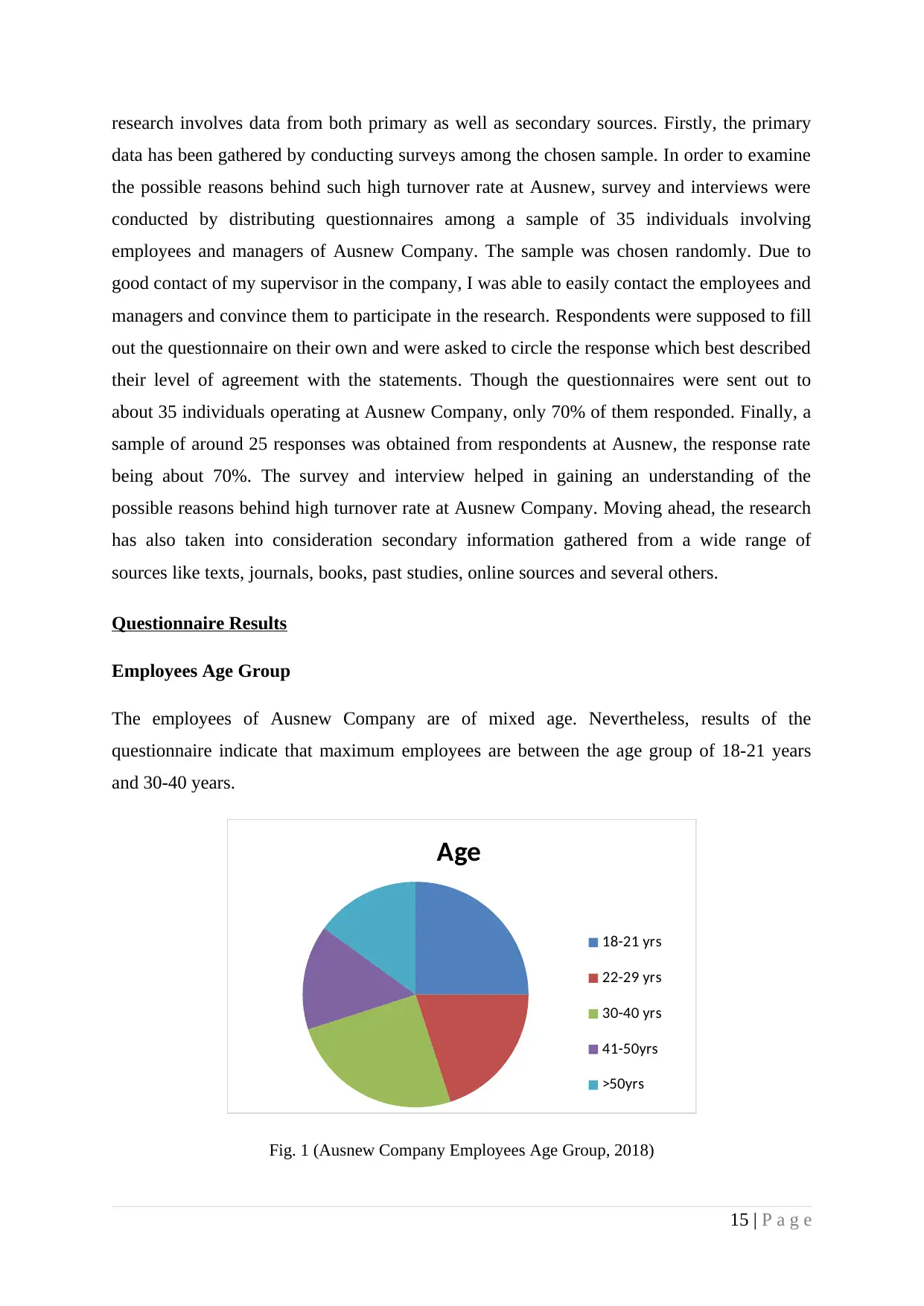
research involves data from both primary as well as secondary sources. Firstly, the primary
data has been gathered by conducting surveys among the chosen sample. In order to examine
the possible reasons behind such high turnover rate at Ausnew, survey and interviews were
conducted by distributing questionnaires among a sample of 35 individuals involving
employees and managers of Ausnew Company. The sample was chosen randomly. Due to
good contact of my supervisor in the company, I was able to easily contact the employees and
managers and convince them to participate in the research. Respondents were supposed to fill
out the questionnaire on their own and were asked to circle the response which best described
their level of agreement with the statements. Though the questionnaires were sent out to
about 35 individuals operating at Ausnew Company, only 70% of them responded. Finally, a
sample of around 25 responses was obtained from respondents at Ausnew, the response rate
being about 70%. The survey and interview helped in gaining an understanding of the
possible reasons behind high turnover rate at Ausnew Company. Moving ahead, the research
has also taken into consideration secondary information gathered from a wide range of
sources like texts, journals, books, past studies, online sources and several others.
Questionnaire Results
Employees Age Group
The employees of Ausnew Company are of mixed age. Nevertheless, results of the
questionnaire indicate that maximum employees are between the age group of 18-21 years
and 30-40 years.
Age
18-21 yrs
22-29 yrs
30-40 yrs
41-50yrs
>50yrs
Fig. 1 (Ausnew Company Employees Age Group, 2018)
15 | P a g e
data has been gathered by conducting surveys among the chosen sample. In order to examine
the possible reasons behind such high turnover rate at Ausnew, survey and interviews were
conducted by distributing questionnaires among a sample of 35 individuals involving
employees and managers of Ausnew Company. The sample was chosen randomly. Due to
good contact of my supervisor in the company, I was able to easily contact the employees and
managers and convince them to participate in the research. Respondents were supposed to fill
out the questionnaire on their own and were asked to circle the response which best described
their level of agreement with the statements. Though the questionnaires were sent out to
about 35 individuals operating at Ausnew Company, only 70% of them responded. Finally, a
sample of around 25 responses was obtained from respondents at Ausnew, the response rate
being about 70%. The survey and interview helped in gaining an understanding of the
possible reasons behind high turnover rate at Ausnew Company. Moving ahead, the research
has also taken into consideration secondary information gathered from a wide range of
sources like texts, journals, books, past studies, online sources and several others.
Questionnaire Results
Employees Age Group
The employees of Ausnew Company are of mixed age. Nevertheless, results of the
questionnaire indicate that maximum employees are between the age group of 18-21 years
and 30-40 years.
Age
18-21 yrs
22-29 yrs
30-40 yrs
41-50yrs
>50yrs
Fig. 1 (Ausnew Company Employees Age Group, 2018)
15 | P a g e
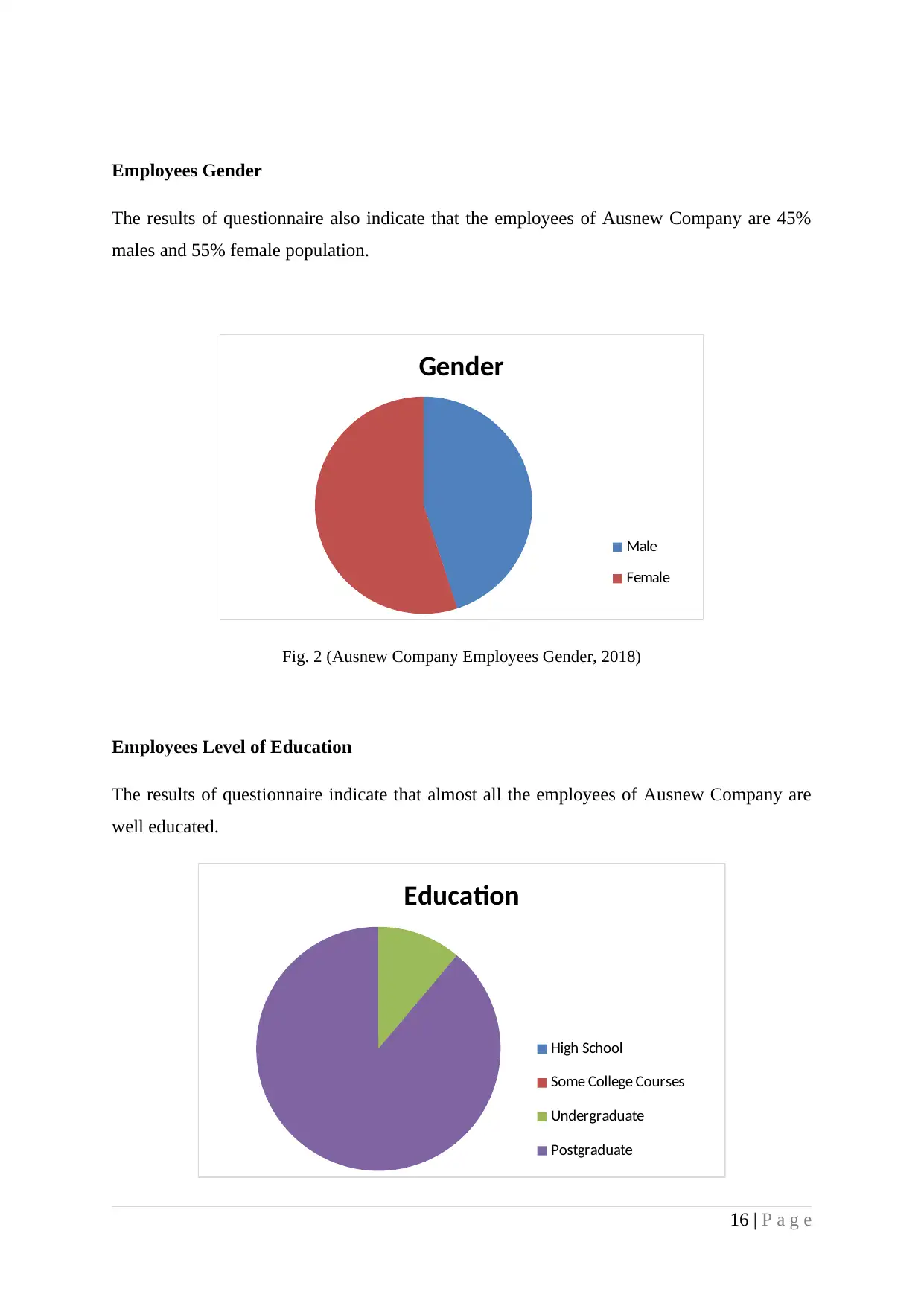
Employees Gender
The results of questionnaire also indicate that the employees of Ausnew Company are 45%
males and 55% female population.
Gender
Male
Female
Fig. 2 (Ausnew Company Employees Gender, 2018)
Employees Level of Education
The results of questionnaire indicate that almost all the employees of Ausnew Company are
well educated.
Education
High School
Some College Courses
Undergraduate
Postgraduate
16 | P a g e
The results of questionnaire also indicate that the employees of Ausnew Company are 45%
males and 55% female population.
Gender
Male
Female
Fig. 2 (Ausnew Company Employees Gender, 2018)
Employees Level of Education
The results of questionnaire indicate that almost all the employees of Ausnew Company are
well educated.
Education
High School
Some College Courses
Undergraduate
Postgraduate
16 | P a g e
Secure Best Marks with AI Grader
Need help grading? Try our AI Grader for instant feedback on your assignments.

Fig. 3 (Employees Education, 2018)
Employees Position
The results of questionnaire clearly indicate that employees and managers were involved in
the study.
Position
Employees Managers
Fig. 4 (Employees Position, 2018)
Satisfaction Level
The questionnaire results show that the majority of individuals are not satisfied with the
company and its provisions.
Satisfaction
Highly satisfied
Satisfied
Neutral
Unsatisafied
Highlu unsatisfied
Fig. 5 (Satisfaction level, 2018)
17 | P a g e
Employees Position
The results of questionnaire clearly indicate that employees and managers were involved in
the study.
Position
Employees Managers
Fig. 4 (Employees Position, 2018)
Satisfaction Level
The questionnaire results show that the majority of individuals are not satisfied with the
company and its provisions.
Satisfaction
Highly satisfied
Satisfied
Neutral
Unsatisafied
Highlu unsatisfied
Fig. 5 (Satisfaction level, 2018)
17 | P a g e
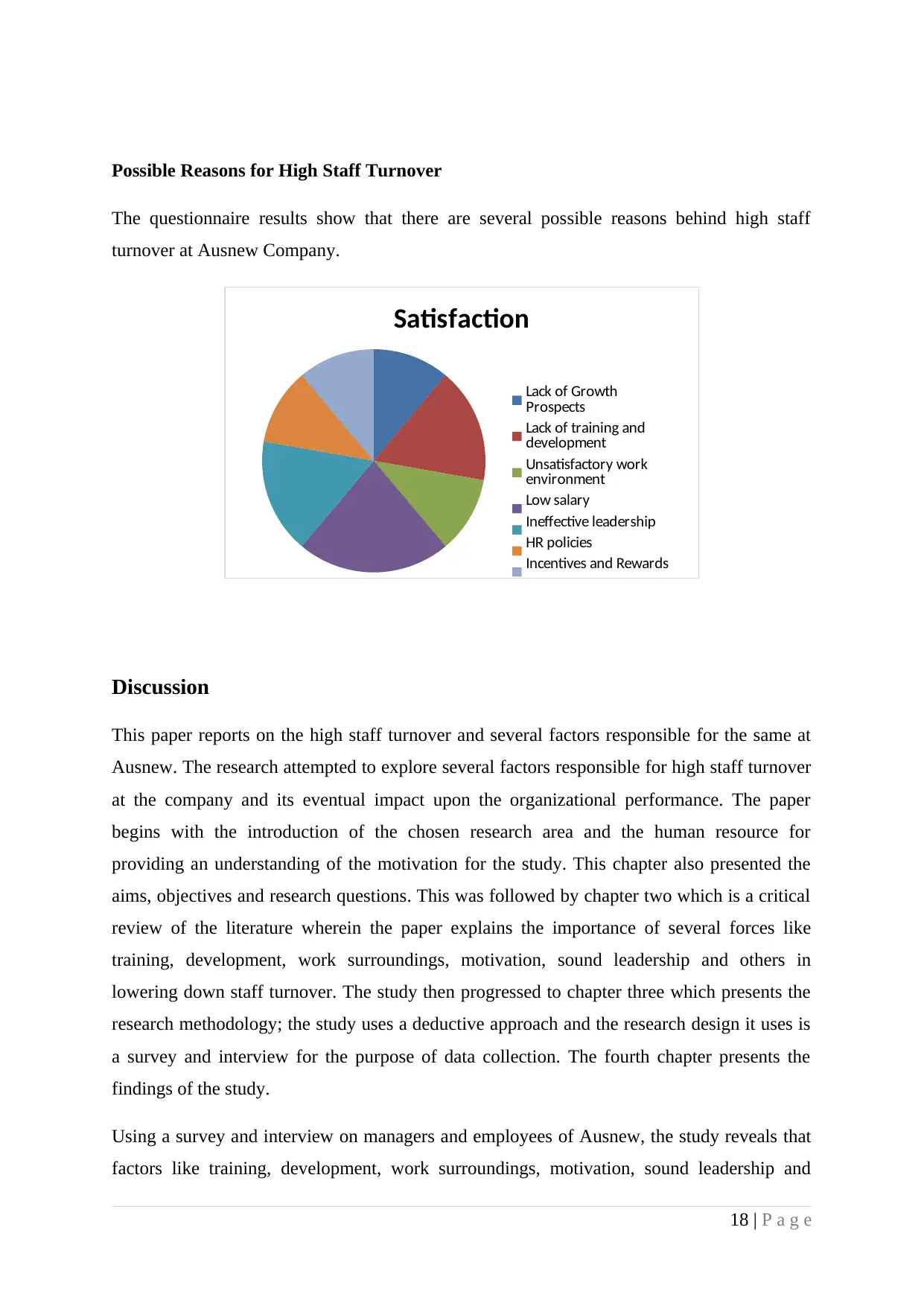
Possible Reasons for High Staff Turnover
The questionnaire results show that there are several possible reasons behind high staff
turnover at Ausnew Company.
Satisfaction
Lack of Growth
Prospects
Lack of training and
development
Unsatisfactory work
environment
Low salary
Ineffective leadership
HR policies
Incentives and Rewards
Discussion
This paper reports on the high staff turnover and several factors responsible for the same at
Ausnew. The research attempted to explore several factors responsible for high staff turnover
at the company and its eventual impact upon the organizational performance. The paper
begins with the introduction of the chosen research area and the human resource for
providing an understanding of the motivation for the study. This chapter also presented the
aims, objectives and research questions. This was followed by chapter two which is a critical
review of the literature wherein the paper explains the importance of several forces like
training, development, work surroundings, motivation, sound leadership and others in
lowering down staff turnover. The study then progressed to chapter three which presents the
research methodology; the study uses a deductive approach and the research design it uses is
a survey and interview for the purpose of data collection. The fourth chapter presents the
findings of the study.
Using a survey and interview on managers and employees of Ausnew, the study reveals that
factors like training, development, work surroundings, motivation, sound leadership and
18 | P a g e
The questionnaire results show that there are several possible reasons behind high staff
turnover at Ausnew Company.
Satisfaction
Lack of Growth
Prospects
Lack of training and
development
Unsatisfactory work
environment
Low salary
Ineffective leadership
HR policies
Incentives and Rewards
Discussion
This paper reports on the high staff turnover and several factors responsible for the same at
Ausnew. The research attempted to explore several factors responsible for high staff turnover
at the company and its eventual impact upon the organizational performance. The paper
begins with the introduction of the chosen research area and the human resource for
providing an understanding of the motivation for the study. This chapter also presented the
aims, objectives and research questions. This was followed by chapter two which is a critical
review of the literature wherein the paper explains the importance of several forces like
training, development, work surroundings, motivation, sound leadership and others in
lowering down staff turnover. The study then progressed to chapter three which presents the
research methodology; the study uses a deductive approach and the research design it uses is
a survey and interview for the purpose of data collection. The fourth chapter presents the
findings of the study.
Using a survey and interview on managers and employees of Ausnew, the study reveals that
factors like training, development, work surroundings, motivation, sound leadership and
18 | P a g e
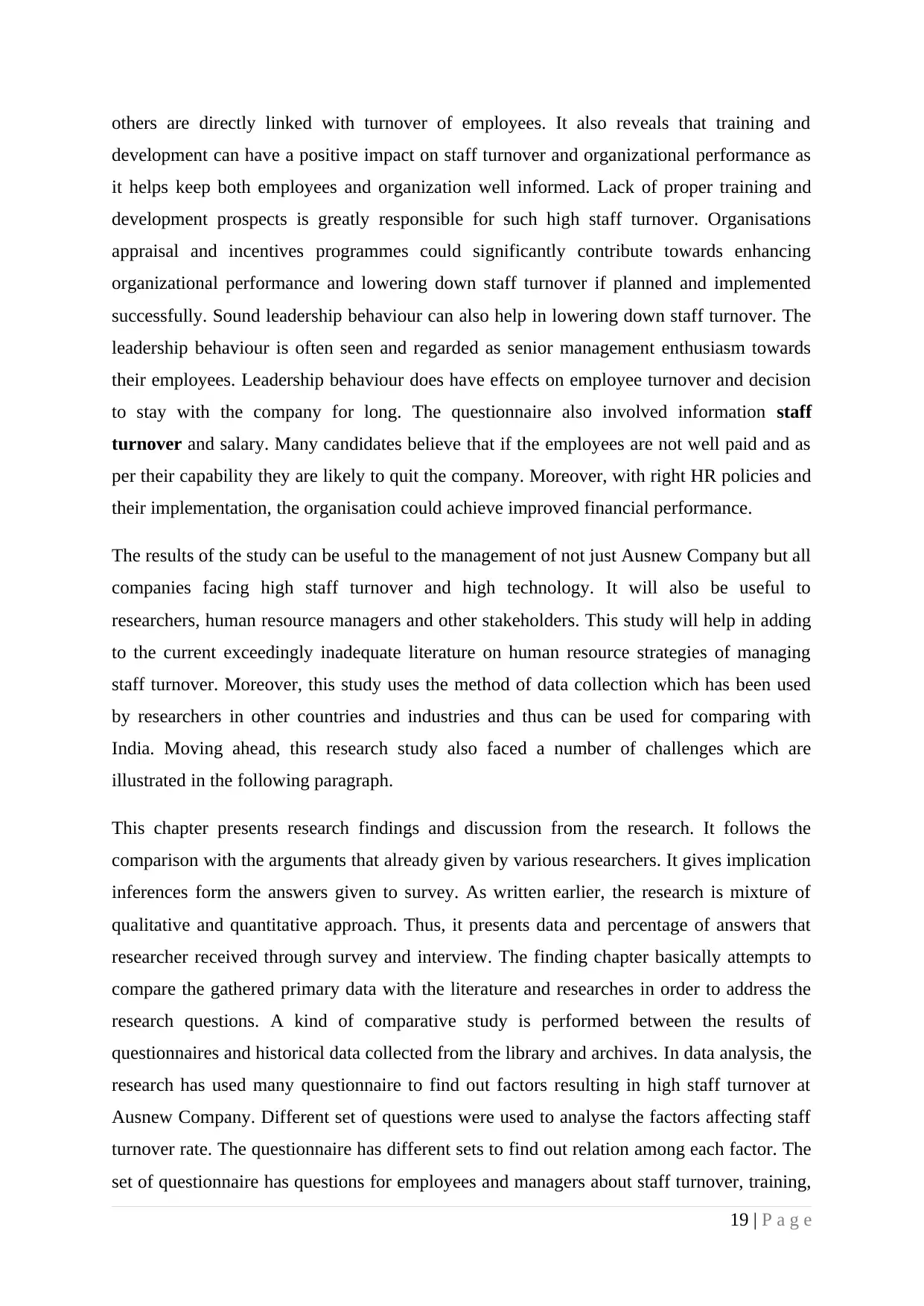
others are directly linked with turnover of employees. It also reveals that training and
development can have a positive impact on staff turnover and organizational performance as
it helps keep both employees and organization well informed. Lack of proper training and
development prospects is greatly responsible for such high staff turnover. Organisations
appraisal and incentives programmes could significantly contribute towards enhancing
organizational performance and lowering down staff turnover if planned and implemented
successfully. Sound leadership behaviour can also help in lowering down staff turnover. The
leadership behaviour is often seen and regarded as senior management enthusiasm towards
their employees. Leadership behaviour does have effects on employee turnover and decision
to stay with the company for long. The questionnaire also involved information staff
turnover and salary. Many candidates believe that if the employees are not well paid and as
per their capability they are likely to quit the company. Moreover, with right HR policies and
their implementation, the organisation could achieve improved financial performance.
The results of the study can be useful to the management of not just Ausnew Company but all
companies facing high staff turnover and high technology. It will also be useful to
researchers, human resource managers and other stakeholders. This study will help in adding
to the current exceedingly inadequate literature on human resource strategies of managing
staff turnover. Moreover, this study uses the method of data collection which has been used
by researchers in other countries and industries and thus can be used for comparing with
India. Moving ahead, this research study also faced a number of challenges which are
illustrated in the following paragraph.
This chapter presents research findings and discussion from the research. It follows the
comparison with the arguments that already given by various researchers. It gives implication
inferences form the answers given to survey. As written earlier, the research is mixture of
qualitative and quantitative approach. Thus, it presents data and percentage of answers that
researcher received through survey and interview. The finding chapter basically attempts to
compare the gathered primary data with the literature and researches in order to address the
research questions. A kind of comparative study is performed between the results of
questionnaires and historical data collected from the library and archives. In data analysis, the
research has used many questionnaire to find out factors resulting in high staff turnover at
Ausnew Company. Different set of questions were used to analyse the factors affecting staff
turnover rate. The questionnaire has different sets to find out relation among each factor. The
set of questionnaire has questions for employees and managers about staff turnover, training,
19 | P a g e
development can have a positive impact on staff turnover and organizational performance as
it helps keep both employees and organization well informed. Lack of proper training and
development prospects is greatly responsible for such high staff turnover. Organisations
appraisal and incentives programmes could significantly contribute towards enhancing
organizational performance and lowering down staff turnover if planned and implemented
successfully. Sound leadership behaviour can also help in lowering down staff turnover. The
leadership behaviour is often seen and regarded as senior management enthusiasm towards
their employees. Leadership behaviour does have effects on employee turnover and decision
to stay with the company for long. The questionnaire also involved information staff
turnover and salary. Many candidates believe that if the employees are not well paid and as
per their capability they are likely to quit the company. Moreover, with right HR policies and
their implementation, the organisation could achieve improved financial performance.
The results of the study can be useful to the management of not just Ausnew Company but all
companies facing high staff turnover and high technology. It will also be useful to
researchers, human resource managers and other stakeholders. This study will help in adding
to the current exceedingly inadequate literature on human resource strategies of managing
staff turnover. Moreover, this study uses the method of data collection which has been used
by researchers in other countries and industries and thus can be used for comparing with
India. Moving ahead, this research study also faced a number of challenges which are
illustrated in the following paragraph.
This chapter presents research findings and discussion from the research. It follows the
comparison with the arguments that already given by various researchers. It gives implication
inferences form the answers given to survey. As written earlier, the research is mixture of
qualitative and quantitative approach. Thus, it presents data and percentage of answers that
researcher received through survey and interview. The finding chapter basically attempts to
compare the gathered primary data with the literature and researches in order to address the
research questions. A kind of comparative study is performed between the results of
questionnaires and historical data collected from the library and archives. In data analysis, the
research has used many questionnaire to find out factors resulting in high staff turnover at
Ausnew Company. Different set of questions were used to analyse the factors affecting staff
turnover rate. The questionnaire has different sets to find out relation among each factor. The
set of questionnaire has questions for employees and managers about staff turnover, training,
19 | P a g e
Paraphrase This Document
Need a fresh take? Get an instant paraphrase of this document with our AI Paraphraser
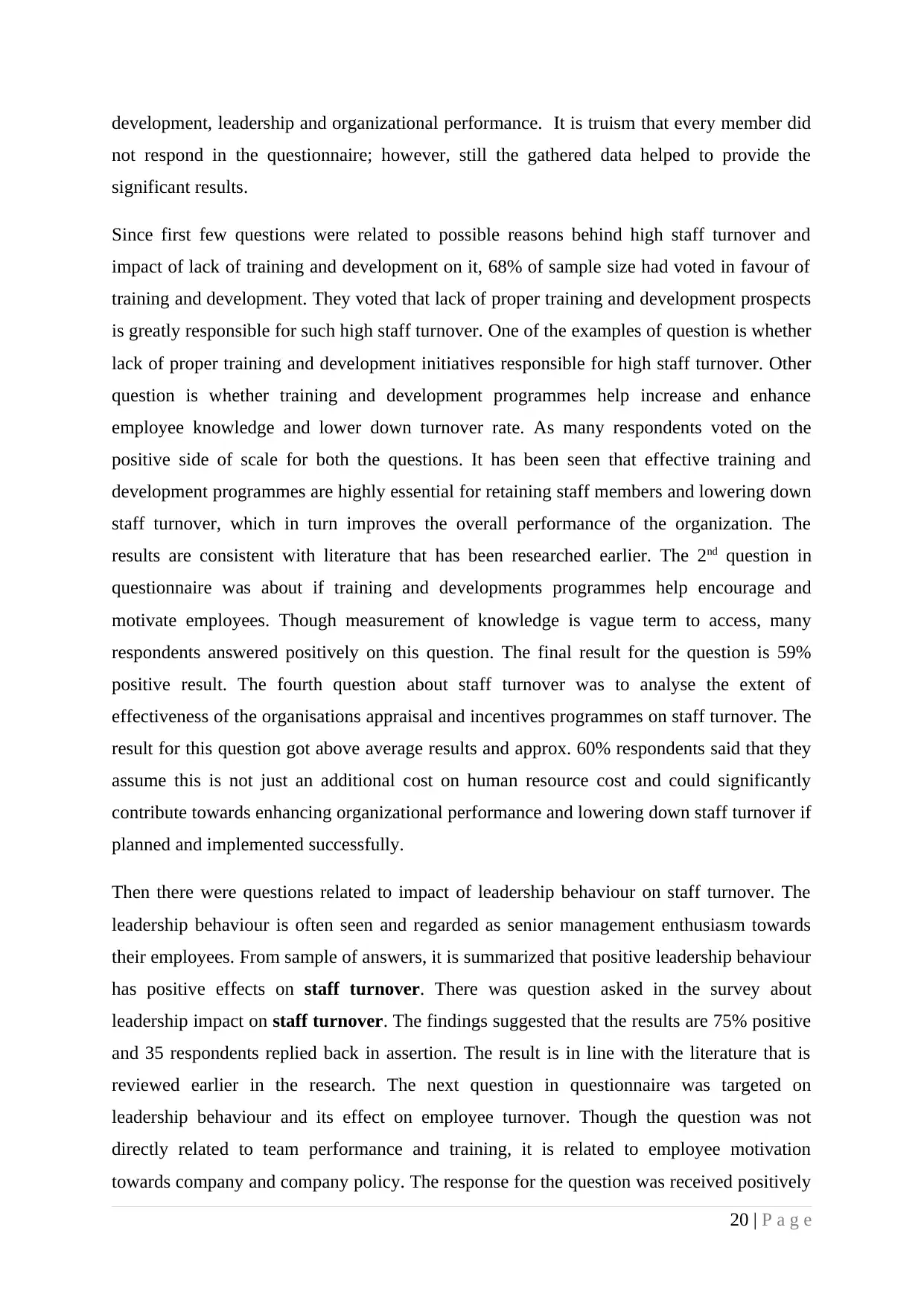
development, leadership and organizational performance. It is truism that every member did
not respond in the questionnaire; however, still the gathered data helped to provide the
significant results.
Since first few questions were related to possible reasons behind high staff turnover and
impact of lack of training and development on it, 68% of sample size had voted in favour of
training and development. They voted that lack of proper training and development prospects
is greatly responsible for such high staff turnover. One of the examples of question is whether
lack of proper training and development initiatives responsible for high staff turnover. Other
question is whether training and development programmes help increase and enhance
employee knowledge and lower down turnover rate. As many respondents voted on the
positive side of scale for both the questions. It has been seen that effective training and
development programmes are highly essential for retaining staff members and lowering down
staff turnover, which in turn improves the overall performance of the organization. The
results are consistent with literature that has been researched earlier. The 2nd question in
questionnaire was about if training and developments programmes help encourage and
motivate employees. Though measurement of knowledge is vague term to access, many
respondents answered positively on this question. The final result for the question is 59%
positive result. The fourth question about staff turnover was to analyse the extent of
effectiveness of the organisations appraisal and incentives programmes on staff turnover. The
result for this question got above average results and approx. 60% respondents said that they
assume this is not just an additional cost on human resource cost and could significantly
contribute towards enhancing organizational performance and lowering down staff turnover if
planned and implemented successfully.
Then there were questions related to impact of leadership behaviour on staff turnover. The
leadership behaviour is often seen and regarded as senior management enthusiasm towards
their employees. From sample of answers, it is summarized that positive leadership behaviour
has positive effects on staff turnover. There was question asked in the survey about
leadership impact on staff turnover. The findings suggested that the results are 75% positive
and 35 respondents replied back in assertion. The result is in line with the literature that is
reviewed earlier in the research. The next question in questionnaire was targeted on
leadership behaviour and its effect on employee turnover. Though the question was not
directly related to team performance and training, it is related to employee motivation
towards company and company policy. The response for the question was received positively
20 | P a g e
not respond in the questionnaire; however, still the gathered data helped to provide the
significant results.
Since first few questions were related to possible reasons behind high staff turnover and
impact of lack of training and development on it, 68% of sample size had voted in favour of
training and development. They voted that lack of proper training and development prospects
is greatly responsible for such high staff turnover. One of the examples of question is whether
lack of proper training and development initiatives responsible for high staff turnover. Other
question is whether training and development programmes help increase and enhance
employee knowledge and lower down turnover rate. As many respondents voted on the
positive side of scale for both the questions. It has been seen that effective training and
development programmes are highly essential for retaining staff members and lowering down
staff turnover, which in turn improves the overall performance of the organization. The
results are consistent with literature that has been researched earlier. The 2nd question in
questionnaire was about if training and developments programmes help encourage and
motivate employees. Though measurement of knowledge is vague term to access, many
respondents answered positively on this question. The final result for the question is 59%
positive result. The fourth question about staff turnover was to analyse the extent of
effectiveness of the organisations appraisal and incentives programmes on staff turnover. The
result for this question got above average results and approx. 60% respondents said that they
assume this is not just an additional cost on human resource cost and could significantly
contribute towards enhancing organizational performance and lowering down staff turnover if
planned and implemented successfully.
Then there were questions related to impact of leadership behaviour on staff turnover. The
leadership behaviour is often seen and regarded as senior management enthusiasm towards
their employees. From sample of answers, it is summarized that positive leadership behaviour
has positive effects on staff turnover. There was question asked in the survey about
leadership impact on staff turnover. The findings suggested that the results are 75% positive
and 35 respondents replied back in assertion. The result is in line with the literature that is
reviewed earlier in the research. The next question in questionnaire was targeted on
leadership behaviour and its effect on employee turnover. Though the question was not
directly related to team performance and training, it is related to employee motivation
towards company and company policy. The response for the question was received positively
20 | P a g e
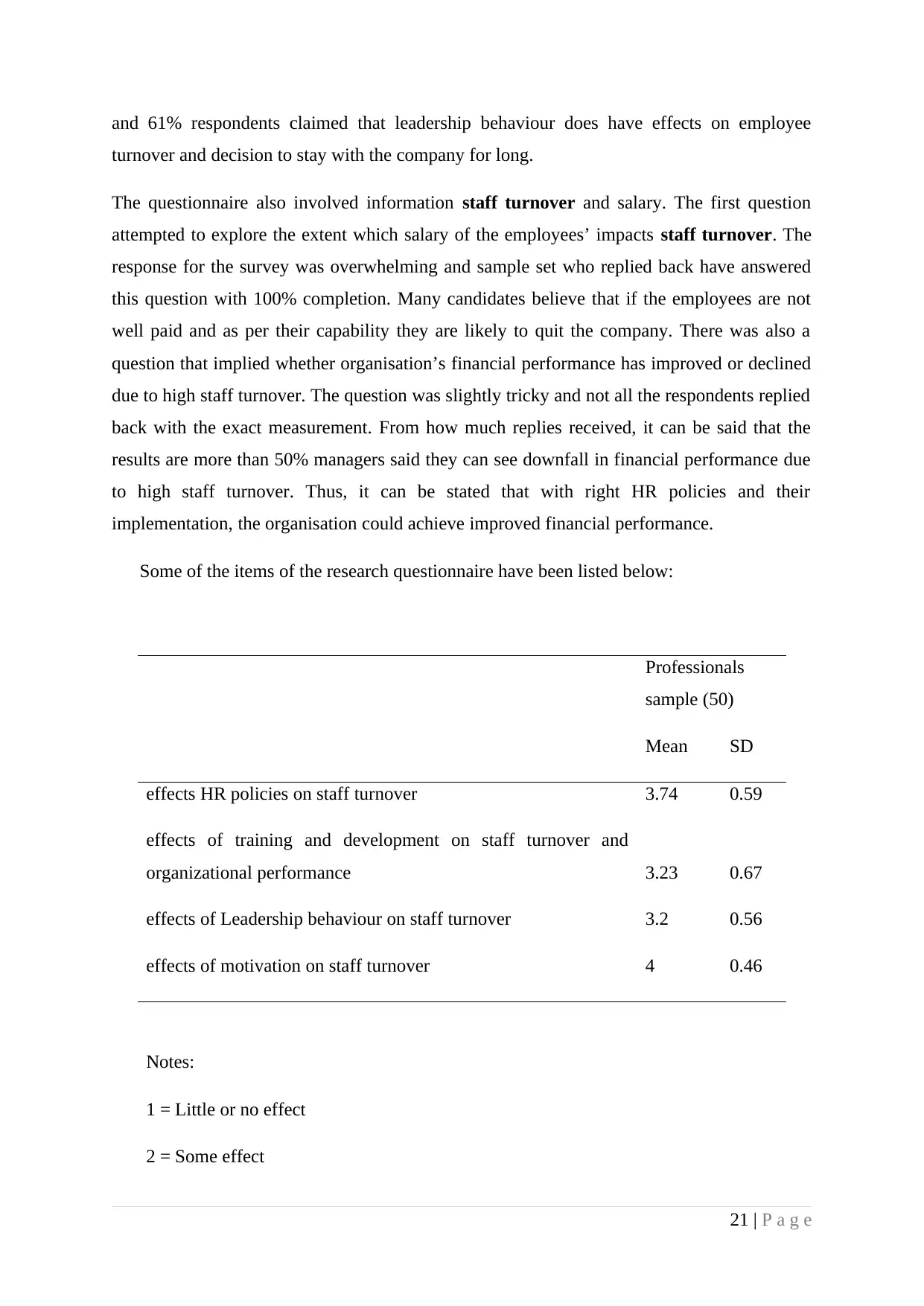
and 61% respondents claimed that leadership behaviour does have effects on employee
turnover and decision to stay with the company for long.
The questionnaire also involved information staff turnover and salary. The first question
attempted to explore the extent which salary of the employees’ impacts staff turnover. The
response for the survey was overwhelming and sample set who replied back have answered
this question with 100% completion. Many candidates believe that if the employees are not
well paid and as per their capability they are likely to quit the company. There was also a
question that implied whether organisation’s financial performance has improved or declined
due to high staff turnover. The question was slightly tricky and not all the respondents replied
back with the exact measurement. From how much replies received, it can be said that the
results are more than 50% managers said they can see downfall in financial performance due
to high staff turnover. Thus, it can be stated that with right HR policies and their
implementation, the organisation could achieve improved financial performance.
Some of the items of the research questionnaire have been listed below:
Professionals
sample (50)
Mean SD
effects HR policies on staff turnover 3.74 0.59
effects of training and development on staff turnover and
organizational performance 3.23 0.67
effects of Leadership behaviour on staff turnover 3.2 0.56
effects of motivation on staff turnover 4 0.46
Notes:
1 = Little or no effect
2 = Some effect
21 | P a g e
turnover and decision to stay with the company for long.
The questionnaire also involved information staff turnover and salary. The first question
attempted to explore the extent which salary of the employees’ impacts staff turnover. The
response for the survey was overwhelming and sample set who replied back have answered
this question with 100% completion. Many candidates believe that if the employees are not
well paid and as per their capability they are likely to quit the company. There was also a
question that implied whether organisation’s financial performance has improved or declined
due to high staff turnover. The question was slightly tricky and not all the respondents replied
back with the exact measurement. From how much replies received, it can be said that the
results are more than 50% managers said they can see downfall in financial performance due
to high staff turnover. Thus, it can be stated that with right HR policies and their
implementation, the organisation could achieve improved financial performance.
Some of the items of the research questionnaire have been listed below:
Professionals
sample (50)
Mean SD
effects HR policies on staff turnover 3.74 0.59
effects of training and development on staff turnover and
organizational performance 3.23 0.67
effects of Leadership behaviour on staff turnover 3.2 0.56
effects of motivation on staff turnover 4 0.46
Notes:
1 = Little or no effect
2 = Some effect
21 | P a g e

3 = moderate effect
4 = great effect
5 = very great effect
Table 1.1 mean and standard deviation table for effects of various strategies on organisational
performance:
The table illustrates the mean and standard deviation for various items that has been asked in
the survey and questionnaire. The answers for each item have been given the scale of 1 to 5. 1
is said to be little or no effect and 5 is assigned as very great effect. 2 is said to be with ‘some
effect’ and 3 is assigned as moderate effect. 4 is said to be great effect. Respondents asked to
choose between the scales of 1 to 5. For example if they choose 1 it means the effect of that
particular item is little or no.
Moving ahead, the table 1.1 shows positive effects of HR and HR policies on staff turnover.
The mean of ‘effects of HR policies on staff turnover and organisational performance’ came
to 3.74 with standard deviation equals to 0.59. The conclusion has come in line with the
literature review done in earlier chapter. The 2nd question of the set has mean of 3.23 with the
standard deviation of 0.67. Thus, it proved that training and development along with
leadership has significant effects on staff turnover. Moving ahead, as said by many scholars,
similar findings have been found and it has been listed in literature review earlier. Theriou &
Chatzoglou (2009) have already proved this point and this research has proved same findings
in line with them. They explained that HRM policies are vital for the dealing with high staff
turnover and development of organisation. And training and learning policies develop good
habits among employee and increased efficiency of entire firm.
The 3rd item has mean value of 3.2 with standard deviation of 0.56. it has proved that
effective leadership behaviour has positively associated with staff turnover. Thus, it has
been proved the first hypothesis listed above. This has proved relation between leadership
behaviour and staff turnover. Senior management should possess the leadership skills for
proper design of HR policies and pursue some HR policies. Specially, HR manager should
have leadership qualities to pursue HR strategies in front of top level management. He needs
to back his HR policies with some facts and figures so that he can implement those strategies
22 | P a g e
4 = great effect
5 = very great effect
Table 1.1 mean and standard deviation table for effects of various strategies on organisational
performance:
The table illustrates the mean and standard deviation for various items that has been asked in
the survey and questionnaire. The answers for each item have been given the scale of 1 to 5. 1
is said to be little or no effect and 5 is assigned as very great effect. 2 is said to be with ‘some
effect’ and 3 is assigned as moderate effect. 4 is said to be great effect. Respondents asked to
choose between the scales of 1 to 5. For example if they choose 1 it means the effect of that
particular item is little or no.
Moving ahead, the table 1.1 shows positive effects of HR and HR policies on staff turnover.
The mean of ‘effects of HR policies on staff turnover and organisational performance’ came
to 3.74 with standard deviation equals to 0.59. The conclusion has come in line with the
literature review done in earlier chapter. The 2nd question of the set has mean of 3.23 with the
standard deviation of 0.67. Thus, it proved that training and development along with
leadership has significant effects on staff turnover. Moving ahead, as said by many scholars,
similar findings have been found and it has been listed in literature review earlier. Theriou &
Chatzoglou (2009) have already proved this point and this research has proved same findings
in line with them. They explained that HRM policies are vital for the dealing with high staff
turnover and development of organisation. And training and learning policies develop good
habits among employee and increased efficiency of entire firm.
The 3rd item has mean value of 3.2 with standard deviation of 0.56. it has proved that
effective leadership behaviour has positively associated with staff turnover. Thus, it has
been proved the first hypothesis listed above. This has proved relation between leadership
behaviour and staff turnover. Senior management should possess the leadership skills for
proper design of HR policies and pursue some HR policies. Specially, HR manager should
have leadership qualities to pursue HR strategies in front of top level management. He needs
to back his HR policies with some facts and figures so that he can implement those strategies
22 | P a g e
Secure Best Marks with AI Grader
Need help grading? Try our AI Grader for instant feedback on your assignments.
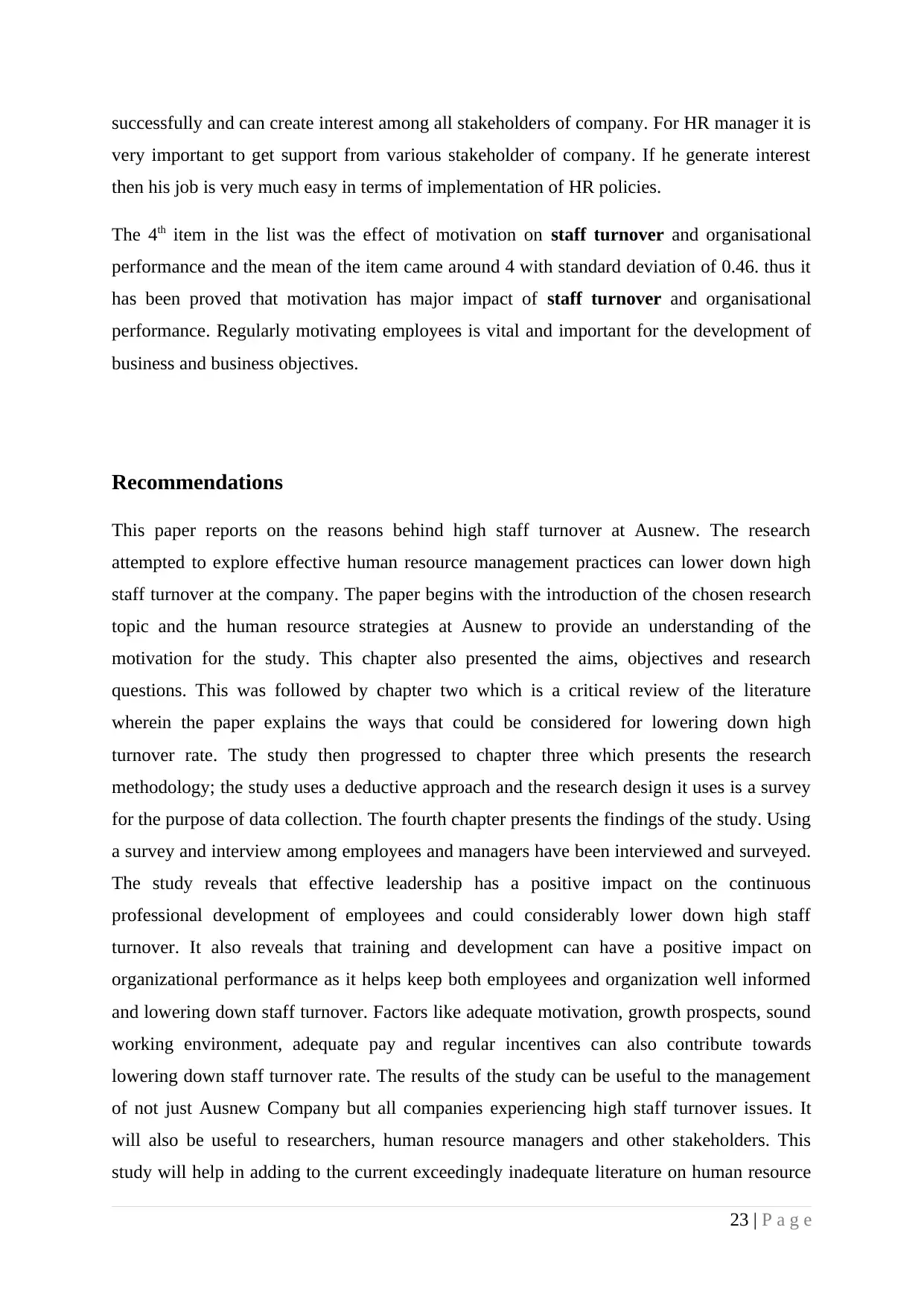
successfully and can create interest among all stakeholders of company. For HR manager it is
very important to get support from various stakeholder of company. If he generate interest
then his job is very much easy in terms of implementation of HR policies.
The 4th item in the list was the effect of motivation on staff turnover and organisational
performance and the mean of the item came around 4 with standard deviation of 0.46. thus it
has been proved that motivation has major impact of staff turnover and organisational
performance. Regularly motivating employees is vital and important for the development of
business and business objectives.
Recommendations
This paper reports on the reasons behind high staff turnover at Ausnew. The research
attempted to explore effective human resource management practices can lower down high
staff turnover at the company. The paper begins with the introduction of the chosen research
topic and the human resource strategies at Ausnew to provide an understanding of the
motivation for the study. This chapter also presented the aims, objectives and research
questions. This was followed by chapter two which is a critical review of the literature
wherein the paper explains the ways that could be considered for lowering down high
turnover rate. The study then progressed to chapter three which presents the research
methodology; the study uses a deductive approach and the research design it uses is a survey
for the purpose of data collection. The fourth chapter presents the findings of the study. Using
a survey and interview among employees and managers have been interviewed and surveyed.
The study reveals that effective leadership has a positive impact on the continuous
professional development of employees and could considerably lower down high staff
turnover. It also reveals that training and development can have a positive impact on
organizational performance as it helps keep both employees and organization well informed
and lowering down staff turnover. Factors like adequate motivation, growth prospects, sound
working environment, adequate pay and regular incentives can also contribute towards
lowering down staff turnover rate. The results of the study can be useful to the management
of not just Ausnew Company but all companies experiencing high staff turnover issues. It
will also be useful to researchers, human resource managers and other stakeholders. This
study will help in adding to the current exceedingly inadequate literature on human resource
23 | P a g e
very important to get support from various stakeholder of company. If he generate interest
then his job is very much easy in terms of implementation of HR policies.
The 4th item in the list was the effect of motivation on staff turnover and organisational
performance and the mean of the item came around 4 with standard deviation of 0.46. thus it
has been proved that motivation has major impact of staff turnover and organisational
performance. Regularly motivating employees is vital and important for the development of
business and business objectives.
Recommendations
This paper reports on the reasons behind high staff turnover at Ausnew. The research
attempted to explore effective human resource management practices can lower down high
staff turnover at the company. The paper begins with the introduction of the chosen research
topic and the human resource strategies at Ausnew to provide an understanding of the
motivation for the study. This chapter also presented the aims, objectives and research
questions. This was followed by chapter two which is a critical review of the literature
wherein the paper explains the ways that could be considered for lowering down high
turnover rate. The study then progressed to chapter three which presents the research
methodology; the study uses a deductive approach and the research design it uses is a survey
for the purpose of data collection. The fourth chapter presents the findings of the study. Using
a survey and interview among employees and managers have been interviewed and surveyed.
The study reveals that effective leadership has a positive impact on the continuous
professional development of employees and could considerably lower down high staff
turnover. It also reveals that training and development can have a positive impact on
organizational performance as it helps keep both employees and organization well informed
and lowering down staff turnover. Factors like adequate motivation, growth prospects, sound
working environment, adequate pay and regular incentives can also contribute towards
lowering down staff turnover rate. The results of the study can be useful to the management
of not just Ausnew Company but all companies experiencing high staff turnover issues. It
will also be useful to researchers, human resource managers and other stakeholders. This
study will help in adding to the current exceedingly inadequate literature on human resource
23 | P a g e

strategies for lowering down high staff turnover. Moving ahead, this research study also
faced a number of challenges which are illustrated in the following paragraph.
Limitations and Conclusion
The findings of this study must be interpreted in the light of the following limitations. Firstly,
though the sample size was adequately large and questionnaires were sent out to a large
number of people; however, only 70% of them responded and thus the results may not be
representative of the entire sample. Future research could attempt to conduct a survey and
interview on a larger sample. Secondly, most previous researchers used either regression or
correlation analysis in order to understand the reasons behind high staff turnover and several
factors responsible for the same. However, due to limitations of time, this study does that
simply on the basis of simple percentage. The study only involved managers and employees,
however further research could be conducted involving top management also in the research.
However, in spite of such limitations, this study makes some important contributions to the
current exceedingly inadequate literature on reasons behind staff turnover and the impact of
the same on organizational performance. This study reveals that forces like training,
development, work surroundings, growth prospects, satisfactory pay, adequate incentives,
motivation and sound leadership and others in lowering down staff turnover. In the words of
Kuchinke (2008), human resource is the most important asset of a company which actually
drive the business strategy.
References:
Ahmad, S., Schroeder, R.G. (2003), "The impact of human resource management practices
on operational performance: recognizing country and industry differences", Journal of
Operations Management, Vol. 21 No.1, pp.19-43.
24 | P a g e
faced a number of challenges which are illustrated in the following paragraph.
Limitations and Conclusion
The findings of this study must be interpreted in the light of the following limitations. Firstly,
though the sample size was adequately large and questionnaires were sent out to a large
number of people; however, only 70% of them responded and thus the results may not be
representative of the entire sample. Future research could attempt to conduct a survey and
interview on a larger sample. Secondly, most previous researchers used either regression or
correlation analysis in order to understand the reasons behind high staff turnover and several
factors responsible for the same. However, due to limitations of time, this study does that
simply on the basis of simple percentage. The study only involved managers and employees,
however further research could be conducted involving top management also in the research.
However, in spite of such limitations, this study makes some important contributions to the
current exceedingly inadequate literature on reasons behind staff turnover and the impact of
the same on organizational performance. This study reveals that forces like training,
development, work surroundings, growth prospects, satisfactory pay, adequate incentives,
motivation and sound leadership and others in lowering down staff turnover. In the words of
Kuchinke (2008), human resource is the most important asset of a company which actually
drive the business strategy.
References:
Ahmad, S., Schroeder, R.G. (2003), "The impact of human resource management practices
on operational performance: recognizing country and industry differences", Journal of
Operations Management, Vol. 21 No.1, pp.19-43.
24 | P a g e
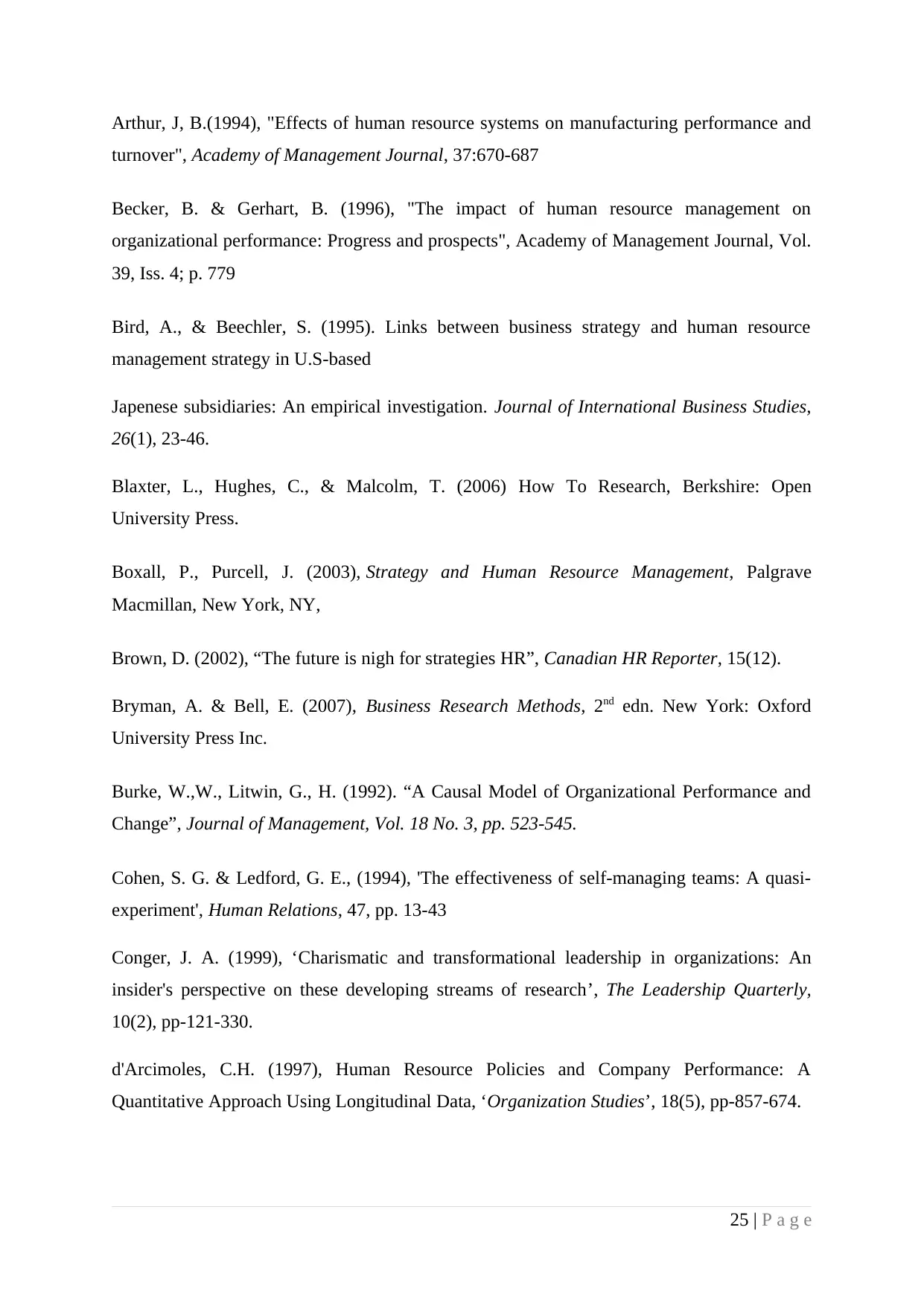
Arthur, J, B.(1994), "Effects of human resource systems on manufacturing performance and
turnover", Academy of Management Journal, 37:670-687
Becker, B. & Gerhart, B. (1996), "The impact of human resource management on
organizational performance: Progress and prospects", Academy of Management Journal, Vol.
39, Iss. 4; p. 779
Bird, A., & Beechler, S. (1995). Links between business strategy and human resource
management strategy in U.S-based
Japenese subsidiaries: An empirical investigation. Journal of International Business Studies,
26(1), 23-46.
Blaxter, L., Hughes, C., & Malcolm, T. (2006) How To Research, Berkshire: Open
University Press.
Boxall, P., Purcell, J. (2003), Strategy and Human Resource Management, Palgrave
Macmillan, New York, NY,
Brown, D. (2002), “The future is nigh for strategies HR”, Canadian HR Reporter, 15(12).
Bryman, A. & Bell, E. (2007), Business Research Methods, 2nd edn. New York: Oxford
University Press Inc.
Burke, W.,W., Litwin, G., H. (1992). “A Causal Model of Organizational Performance and
Change”, Journal of Management, Vol. 18 No. 3, pp. 523-545.
Cohen, S. G. & Ledford, G. E., (1994), 'The effectiveness of self-managing teams: A quasi-
experiment', Human Relations, 47, pp. 13-43
Conger, J. A. (1999), ‘Charismatic and transformational leadership in organizations: An
insider's perspective on these developing streams of research’, The Leadership Quarterly,
10(2), pp-121-330.
d'Arcimoles, C.H. (1997), Human Resource Policies and Company Performance: A
Quantitative Approach Using Longitudinal Data, ‘Organization Studies’, 18(5), pp-857-674.
25 | P a g e
turnover", Academy of Management Journal, 37:670-687
Becker, B. & Gerhart, B. (1996), "The impact of human resource management on
organizational performance: Progress and prospects", Academy of Management Journal, Vol.
39, Iss. 4; p. 779
Bird, A., & Beechler, S. (1995). Links between business strategy and human resource
management strategy in U.S-based
Japenese subsidiaries: An empirical investigation. Journal of International Business Studies,
26(1), 23-46.
Blaxter, L., Hughes, C., & Malcolm, T. (2006) How To Research, Berkshire: Open
University Press.
Boxall, P., Purcell, J. (2003), Strategy and Human Resource Management, Palgrave
Macmillan, New York, NY,
Brown, D. (2002), “The future is nigh for strategies HR”, Canadian HR Reporter, 15(12).
Bryman, A. & Bell, E. (2007), Business Research Methods, 2nd edn. New York: Oxford
University Press Inc.
Burke, W.,W., Litwin, G., H. (1992). “A Causal Model of Organizational Performance and
Change”, Journal of Management, Vol. 18 No. 3, pp. 523-545.
Cohen, S. G. & Ledford, G. E., (1994), 'The effectiveness of self-managing teams: A quasi-
experiment', Human Relations, 47, pp. 13-43
Conger, J. A. (1999), ‘Charismatic and transformational leadership in organizations: An
insider's perspective on these developing streams of research’, The Leadership Quarterly,
10(2), pp-121-330.
d'Arcimoles, C.H. (1997), Human Resource Policies and Company Performance: A
Quantitative Approach Using Longitudinal Data, ‘Organization Studies’, 18(5), pp-857-674.
25 | P a g e
Paraphrase This Document
Need a fresh take? Get an instant paraphrase of this document with our AI Paraphraser
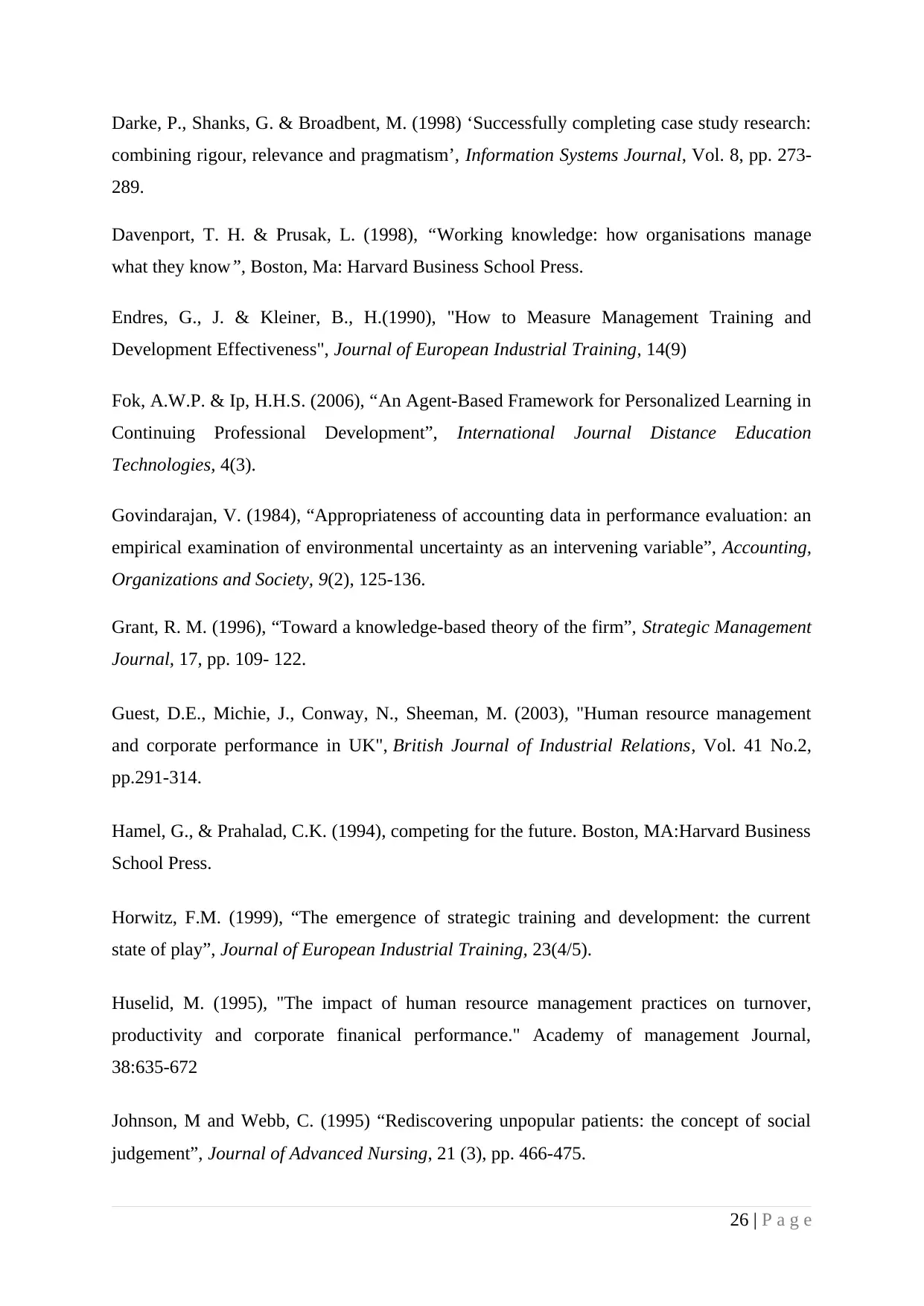
Darke, P., Shanks, G. & Broadbent, M. (1998) ‘Successfully completing case study research:
combining rigour, relevance and pragmatism’, Information Systems Journal, Vol. 8, pp. 273-
289.
Davenport, T. H. & Prusak, L. (1998), “Working knowledge: how organisations manage
what they know”, Boston, Ma: Harvard Business School Press.
Endres, G., J. & Kleiner, B., H.(1990), "How to Measure Management Training and
Development Effectiveness", Journal of European Industrial Training, 14(9)
Fok, A.W.P. & Ip, H.H.S. (2006), “An Agent-Based Framework for Personalized Learning in
Continuing Professional Development”, International Journal Distance Education
Technologies, 4(3).
Govindarajan, V. (1984), “Appropriateness of accounting data in performance evaluation: an
empirical examination of environmental uncertainty as an intervening variable”, Accounting,
Organizations and Society, 9(2), 125-136.
Grant, R. M. (1996), “Toward a knowledge-based theory of the firm”, Strategic Management
Journal, 17, pp. 109- 122.
Guest, D.E., Michie, J., Conway, N., Sheeman, M. (2003), "Human resource management
and corporate performance in UK", British Journal of Industrial Relations, Vol. 41 No.2,
pp.291-314.
Hamel, G., & Prahalad, C.K. (1994), competing for the future. Boston, MA:Harvard Business
School Press.
Horwitz, F.M. (1999), “The emergence of strategic training and development: the current
state of play”, Journal of European Industrial Training, 23(4/5).
Huselid, M. (1995), "The impact of human resource management practices on turnover,
productivity and corporate finanical performance." Academy of management Journal,
38:635-672
Johnson, M and Webb, C. (1995) “Rediscovering unpopular patients: the concept of social
judgement”, Journal of Advanced Nursing, 21 (3), pp. 466-475.
26 | P a g e
combining rigour, relevance and pragmatism’, Information Systems Journal, Vol. 8, pp. 273-
289.
Davenport, T. H. & Prusak, L. (1998), “Working knowledge: how organisations manage
what they know”, Boston, Ma: Harvard Business School Press.
Endres, G., J. & Kleiner, B., H.(1990), "How to Measure Management Training and
Development Effectiveness", Journal of European Industrial Training, 14(9)
Fok, A.W.P. & Ip, H.H.S. (2006), “An Agent-Based Framework for Personalized Learning in
Continuing Professional Development”, International Journal Distance Education
Technologies, 4(3).
Govindarajan, V. (1984), “Appropriateness of accounting data in performance evaluation: an
empirical examination of environmental uncertainty as an intervening variable”, Accounting,
Organizations and Society, 9(2), 125-136.
Grant, R. M. (1996), “Toward a knowledge-based theory of the firm”, Strategic Management
Journal, 17, pp. 109- 122.
Guest, D.E., Michie, J., Conway, N., Sheeman, M. (2003), "Human resource management
and corporate performance in UK", British Journal of Industrial Relations, Vol. 41 No.2,
pp.291-314.
Hamel, G., & Prahalad, C.K. (1994), competing for the future. Boston, MA:Harvard Business
School Press.
Horwitz, F.M. (1999), “The emergence of strategic training and development: the current
state of play”, Journal of European Industrial Training, 23(4/5).
Huselid, M. (1995), "The impact of human resource management practices on turnover,
productivity and corporate finanical performance." Academy of management Journal,
38:635-672
Johnson, M and Webb, C. (1995) “Rediscovering unpopular patients: the concept of social
judgement”, Journal of Advanced Nursing, 21 (3), pp. 466-475.
26 | P a g e

Kling, J. (1995), “High performance work systems and firm performance”, Monthly Labour
Review, 118 (5), pp. 29-36.
Kuchinke, K. P. (2008), “Strategic human resource development”. Yuan-Ze University:
Illinois.
Lähteenmäki, S., Storey, J. & Vanhala, S. (1997), ‘HRM and company performance: the use
of measurement and the influence of economic cycles’, Human Resource Management
Journal, 8(2), pp. 51-65
Lawler, E. E., Mohrman, S.A. & Ledford, G. E. (1995), 'Creating high performance
organisations:practices and results of employee involvement and total quality management in
fortunre 1000 companies' San Francisco: Jossey-Bass
Lee, Y. H., Hsieh, Y. C. & Cai, S. J. (2009), “A Case Study of the Human Resource
Development and Organizational Performance for the Taiwan High-Tech Industry – Hsin
Chu Science-Based Industrial Park as an example”, Proceedings of 2009 International
Conference on Human Resource Development.
Masalin, L. (2003), “Nokia Leads Change through Continuous Learning”, Academy of
Management Learning and Education, 2(1), pp. 68-72.
Maylor, H. & Blackmon, K. (2005) Researching Business and Management, Vol. 1,
Hampshire: Palgrave MacMillan.
McDowall, A., Saunders, M. N. K. (2010), “UK managers' conceptions of employee training
and development”, Journal of European Industrial Training,34(7).
Mumford, M. D. (2006), “Pathways to outstanding leadership”, Mahwah, NJ: Lawrence
Erlbaum Associates, Publishers.
Osterman, P (1994), ’How common is workplace transformation and who adopts it?’,
Industrial and Labor Relations Review, 47, pp. 173-188.
Peslak, A. (2005), “The importance of information technology: An empirical and longitudinal
study of the annual reports of the 50 largest companies in the United States”, The Journal of
Computer Information Systems, Spring: 32-42.
27 | P a g e
Review, 118 (5), pp. 29-36.
Kuchinke, K. P. (2008), “Strategic human resource development”. Yuan-Ze University:
Illinois.
Lähteenmäki, S., Storey, J. & Vanhala, S. (1997), ‘HRM and company performance: the use
of measurement and the influence of economic cycles’, Human Resource Management
Journal, 8(2), pp. 51-65
Lawler, E. E., Mohrman, S.A. & Ledford, G. E. (1995), 'Creating high performance
organisations:practices and results of employee involvement and total quality management in
fortunre 1000 companies' San Francisco: Jossey-Bass
Lee, Y. H., Hsieh, Y. C. & Cai, S. J. (2009), “A Case Study of the Human Resource
Development and Organizational Performance for the Taiwan High-Tech Industry – Hsin
Chu Science-Based Industrial Park as an example”, Proceedings of 2009 International
Conference on Human Resource Development.
Masalin, L. (2003), “Nokia Leads Change through Continuous Learning”, Academy of
Management Learning and Education, 2(1), pp. 68-72.
Maylor, H. & Blackmon, K. (2005) Researching Business and Management, Vol. 1,
Hampshire: Palgrave MacMillan.
McDowall, A., Saunders, M. N. K. (2010), “UK managers' conceptions of employee training
and development”, Journal of European Industrial Training,34(7).
Mumford, M. D. (2006), “Pathways to outstanding leadership”, Mahwah, NJ: Lawrence
Erlbaum Associates, Publishers.
Osterman, P (1994), ’How common is workplace transformation and who adopts it?’,
Industrial and Labor Relations Review, 47, pp. 173-188.
Peslak, A. (2005), “The importance of information technology: An empirical and longitudinal
study of the annual reports of the 50 largest companies in the United States”, The Journal of
Computer Information Systems, Spring: 32-42.
27 | P a g e
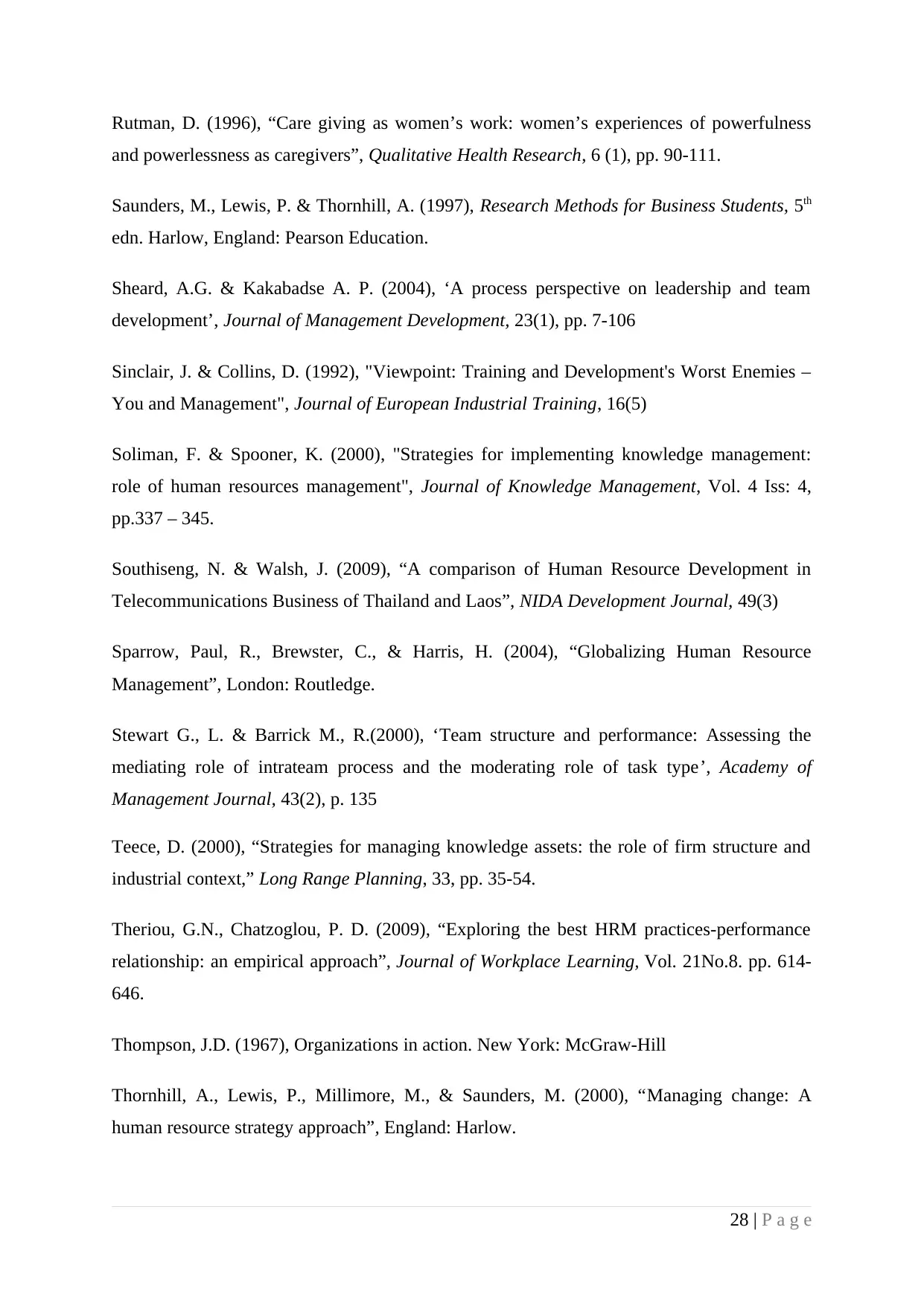
Rutman, D. (1996), “Care giving as women’s work: women’s experiences of powerfulness
and powerlessness as caregivers”, Qualitative Health Research, 6 (1), pp. 90-111.
Saunders, M., Lewis, P. & Thornhill, A. (1997), Research Methods for Business Students, 5th
edn. Harlow, England: Pearson Education.
Sheard, A.G. & Kakabadse A. P. (2004), ‘A process perspective on leadership and team
development’, Journal of Management Development, 23(1), pp. 7-106
Sinclair, J. & Collins, D. (1992), "Viewpoint: Training and Development's Worst Enemies –
You and Management", Journal of European Industrial Training, 16(5)
Soliman, F. & Spooner, K. (2000), "Strategies for implementing knowledge management:
role of human resources management", Journal of Knowledge Management, Vol. 4 Iss: 4,
pp.337 – 345.
Southiseng, N. & Walsh, J. (2009), “A comparison of Human Resource Development in
Telecommunications Business of Thailand and Laos”, NIDA Development Journal, 49(3)
Sparrow, Paul, R., Brewster, C., & Harris, H. (2004), “Globalizing Human Resource
Management”, London: Routledge.
Stewart G., L. & Barrick M., R.(2000), ‘Team structure and performance: Assessing the
mediating role of intrateam process and the moderating role of task type’, Academy of
Management Journal, 43(2), p. 135
Teece, D. (2000), “Strategies for managing knowledge assets: the role of firm structure and
industrial context,” Long Range Planning, 33, pp. 35-54.
Theriou, G.N., Chatzoglou, P. D. (2009), “Exploring the best HRM practices-performance
relationship: an empirical approach”, Journal of Workplace Learning, Vol. 21No.8. pp. 614-
646.
Thompson, J.D. (1967), Organizations in action. New York: McGraw-Hill
Thornhill, A., Lewis, P., Millimore, M., & Saunders, M. (2000), “Managing change: A
human resource strategy approach”, England: Harlow.
28 | P a g e
and powerlessness as caregivers”, Qualitative Health Research, 6 (1), pp. 90-111.
Saunders, M., Lewis, P. & Thornhill, A. (1997), Research Methods for Business Students, 5th
edn. Harlow, England: Pearson Education.
Sheard, A.G. & Kakabadse A. P. (2004), ‘A process perspective on leadership and team
development’, Journal of Management Development, 23(1), pp. 7-106
Sinclair, J. & Collins, D. (1992), "Viewpoint: Training and Development's Worst Enemies –
You and Management", Journal of European Industrial Training, 16(5)
Soliman, F. & Spooner, K. (2000), "Strategies for implementing knowledge management:
role of human resources management", Journal of Knowledge Management, Vol. 4 Iss: 4,
pp.337 – 345.
Southiseng, N. & Walsh, J. (2009), “A comparison of Human Resource Development in
Telecommunications Business of Thailand and Laos”, NIDA Development Journal, 49(3)
Sparrow, Paul, R., Brewster, C., & Harris, H. (2004), “Globalizing Human Resource
Management”, London: Routledge.
Stewart G., L. & Barrick M., R.(2000), ‘Team structure and performance: Assessing the
mediating role of intrateam process and the moderating role of task type’, Academy of
Management Journal, 43(2), p. 135
Teece, D. (2000), “Strategies for managing knowledge assets: the role of firm structure and
industrial context,” Long Range Planning, 33, pp. 35-54.
Theriou, G.N., Chatzoglou, P. D. (2009), “Exploring the best HRM practices-performance
relationship: an empirical approach”, Journal of Workplace Learning, Vol. 21No.8. pp. 614-
646.
Thompson, J.D. (1967), Organizations in action. New York: McGraw-Hill
Thornhill, A., Lewis, P., Millimore, M., & Saunders, M. (2000), “Managing change: A
human resource strategy approach”, England: Harlow.
28 | P a g e
Secure Best Marks with AI Grader
Need help grading? Try our AI Grader for instant feedback on your assignments.
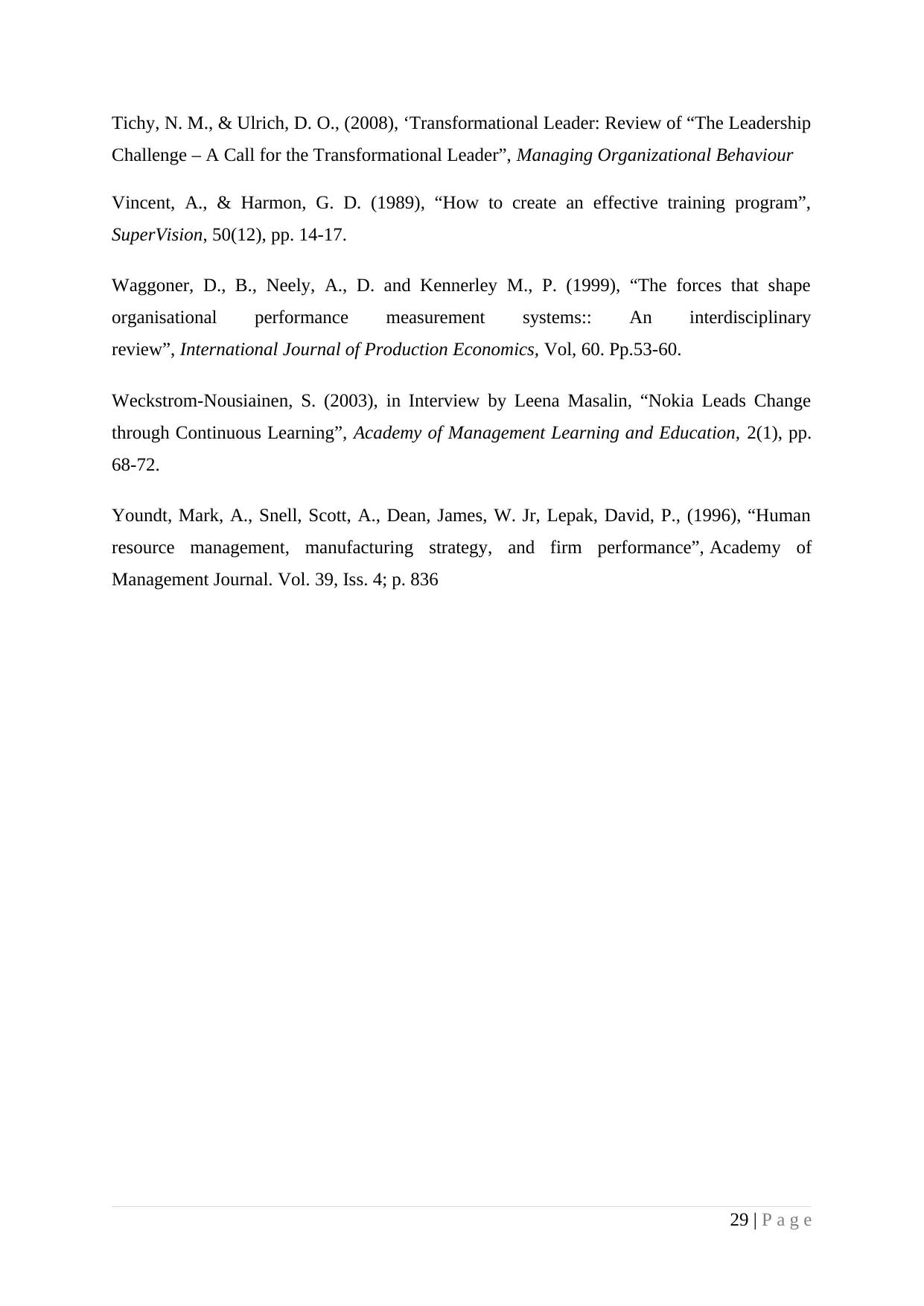
Tichy, N. M., & Ulrich, D. O., (2008), ‘Transformational Leader: Review of “The Leadership
Challenge – A Call for the Transformational Leader”, Managing Organizational Behaviour
Vincent, A., & Harmon, G. D. (1989), “How to create an effective training program”,
SuperVision, 50(12), pp. 14-17.
Waggoner, D., B., Neely, A., D. and Kennerley M., P. (1999), “The forces that shape
organisational performance measurement systems:: An interdisciplinary
review”, International Journal of Production Economics, Vol, 60. Pp.53-60.
Weckstrom-Nousiainen, S. (2003), in Interview by Leena Masalin, “Nokia Leads Change
through Continuous Learning”, Academy of Management Learning and Education, 2(1), pp.
68-72.
Youndt, Mark, A., Snell, Scott, A., Dean, James, W. Jr, Lepak, David, P., (1996), “Human
resource management, manufacturing strategy, and firm performance”, Academy of
Management Journal. Vol. 39, Iss. 4; p. 836
29 | P a g e
Challenge – A Call for the Transformational Leader”, Managing Organizational Behaviour
Vincent, A., & Harmon, G. D. (1989), “How to create an effective training program”,
SuperVision, 50(12), pp. 14-17.
Waggoner, D., B., Neely, A., D. and Kennerley M., P. (1999), “The forces that shape
organisational performance measurement systems:: An interdisciplinary
review”, International Journal of Production Economics, Vol, 60. Pp.53-60.
Weckstrom-Nousiainen, S. (2003), in Interview by Leena Masalin, “Nokia Leads Change
through Continuous Learning”, Academy of Management Learning and Education, 2(1), pp.
68-72.
Youndt, Mark, A., Snell, Scott, A., Dean, James, W. Jr, Lepak, David, P., (1996), “Human
resource management, manufacturing strategy, and firm performance”, Academy of
Management Journal. Vol. 39, Iss. 4; p. 836
29 | P a g e
1 out of 29
Related Documents
Your All-in-One AI-Powered Toolkit for Academic Success.
+13062052269
info@desklib.com
Available 24*7 on WhatsApp / Email
![[object Object]](/_next/static/media/star-bottom.7253800d.svg)
Unlock your academic potential
© 2024 | Zucol Services PVT LTD | All rights reserved.





